Search Result
Results for "
pd-1
" in MedChemExpress (MCE) Product Catalog:
| Cat. No. |
Product Name |
Target |
Research Areas |
Chemical Structure |
-
- HY-101058A
-
-

-
- HY-134886
-
|
|
PD-1/PD-L1
|
Cancer
|
|
PD-1-IN-24 (compound 1) is an orally active PD-1 inhibitor [1].
|
-
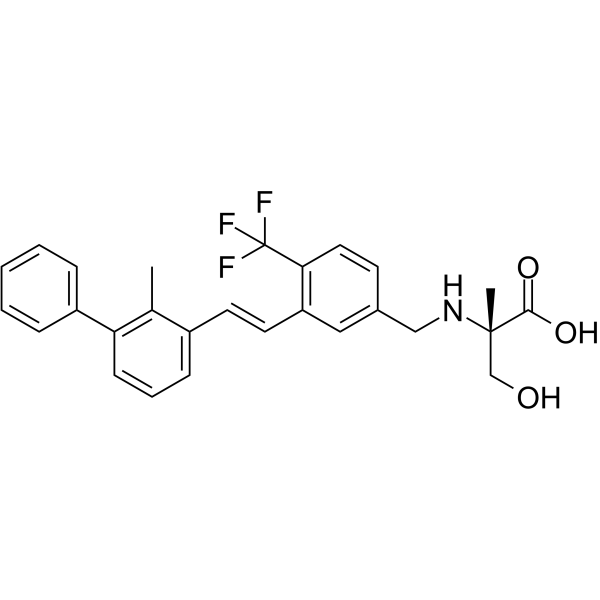
-
- HY-157569
-
|
|
PD-1/PD-L1
|
Cancer
|
|
PD1-PDL1-IN 2 (ZE132) is a potent and selective PD-1/PD-L1 inhibitor, which has robust anti-tumour activity in vivo. PD1-PDL1-IN 2 promotes cytotoxic T-cell tumour infiltration and induces IL-2 expression. In addition, PD1-PDL1-IN 2 elicits strong inhibitory effects on the mRNA expression of TGF-β [1].
|
-

-
- HY-162343
-
-
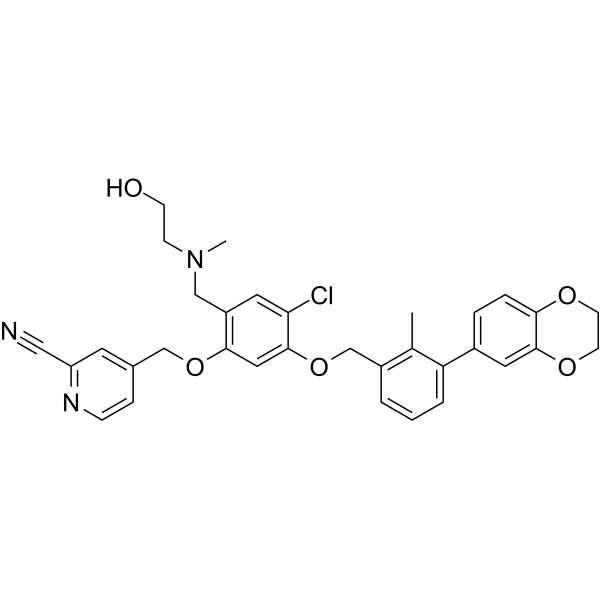
-
- HY-101093B
-
|
|
PD-1/PD-L1
|
Cancer
|
|
PD-1-IN-20 is the less active enantiomer of PD-1-IN-1. PD-1-IN-1 is an inhibitor of programmed cell dealth-1 (PD-1) extracted from patent WO 2015033299 A1, compound example 4 [1].
|
-

-
- HY-101097A
-
|
|
PD-1/PD-L1
|
Cancer
|
|
PD-1-IN-17 TFA is a programmed cell death-1 (PD-1) inhibitor extracted from patent WO2015033301A1, Compound 12, inhibits 92% splenocyte proliferation at 100 nM [1].
|
-
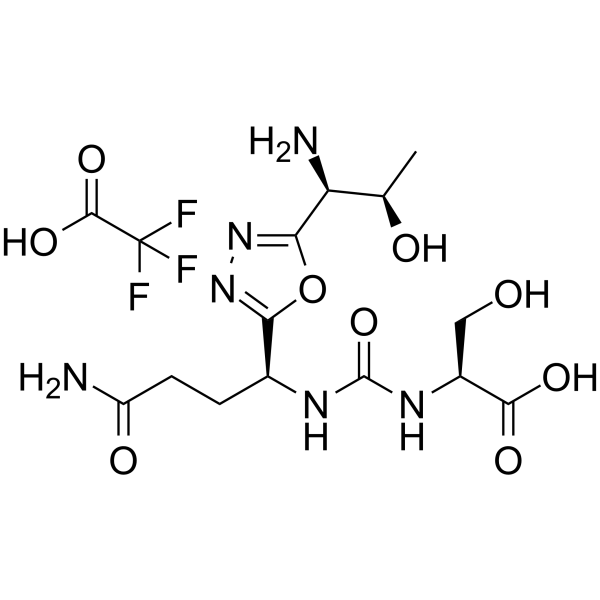
-
- HY-P10217
-
|
|
PD-1/PD-L1
|
Cancer
|
|
PD-1/PD-L1-IN-42 (Compound B8.4) is an inhibitor of the interaction between PD-1 and PD-L1, with an EC50 of 0.1 μM. PD-1/PD-L1-IN-42 can be used for the research of cancer immunotherapy [1].
|
-
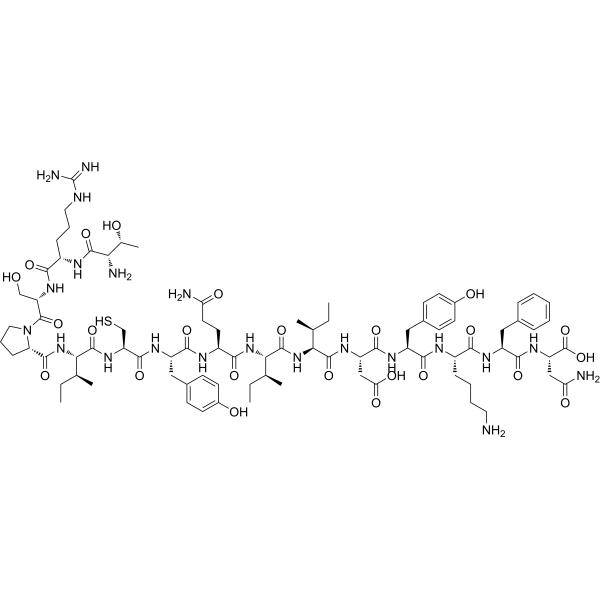
-
- HY-N12537
-
|
|
PD-1/PD-L1
|
Cancer
|
|
PD-1/ PD-L1-in-38 is a PD-1/PD-L1 inhibitor, which can inhibit the proliferation of tumor cells, promote the secretion of INF-γ by CD8 + T cells, and inhibit the ability of PD-1/PD-L1 signal transduction. PD-1/PD-L1-IN-38 has antitumor activity [1].
|
-
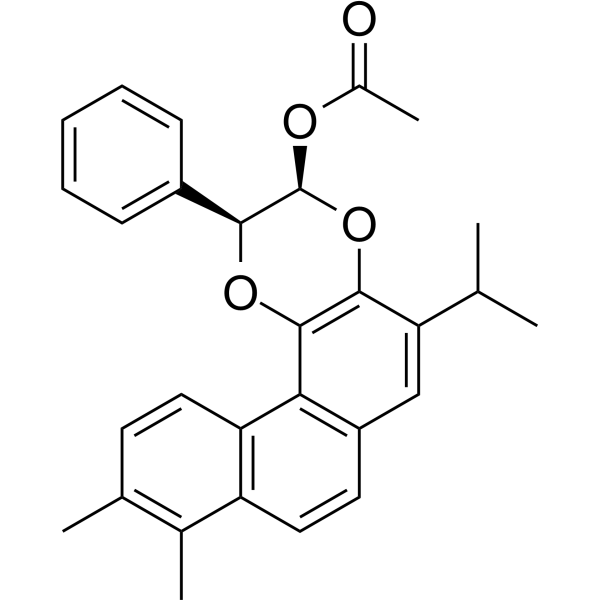
-
- HY-144447
-
|
|
PD-1/PD-L1
|
Cancer
|
|
PD-1/PD-L1-IN-17 (Compound P20) is a potent inhibitor of PD-1/PD-L1 with an IC50 value of 26.8 nM. PD-1/PD-L1-IN-17 is a promising lead compound for the development of inhibitors of the PD-1/PD-L1 interaction. PD-1/PD-L1-IN-17 has the potential for the research of cancer diseases [1].
|
-

-
- HY-158052
-
|
|
PD-1/PD-L1
|
Cancer
|
|
PD-1/PD-L1 antagonist 1 (Compound A5) is an antagonist for programmed cell death-1 (PD-1) and programmed cell death ligand-1 (PD-L1) interaction, with an IC50 of 23.78 nM [1].
|
-
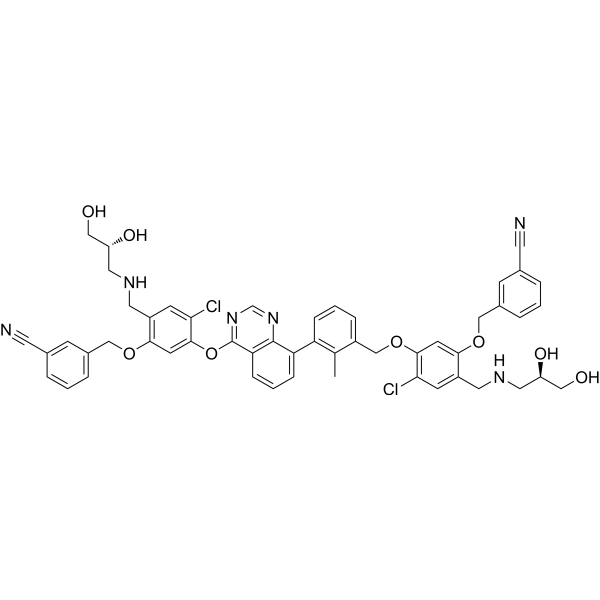
-
- HY-163307
-
|
|
PD-1/PD-L1
|
Cancer
|
|
PD-1/PD-L1-IN-39 (X 14) is an orally active PD-1/PD-L1 inhibitor with a IC50 value of 15.73 nM. PD-1/ PD-L1-in-39 has a good binding affinity for human and mouse PD-L1, with KD values of 14.62 nM and 392 nM, respectively. PD-1/PD-L1-IN-39 has antitumor activity [1].
|
-
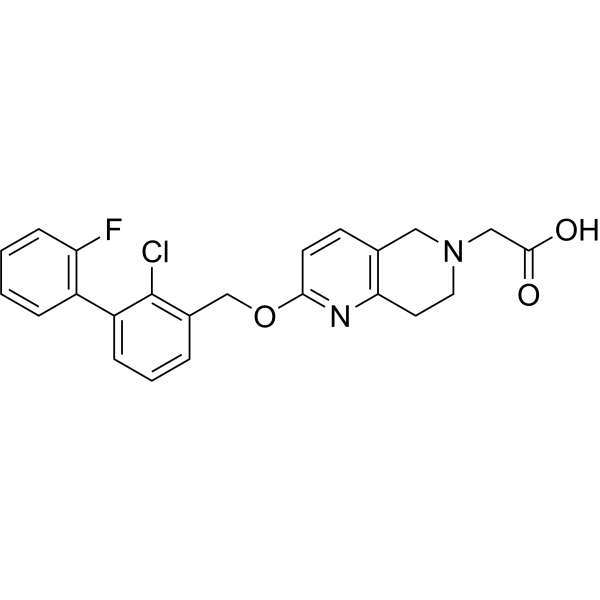
-
- HY-155959
-
|
|
PD-1/PD-L1
|
Cancer
|
|
PD-1/PD-L1-IN-33 (Compound N11) is a PD-1/PD-L1 inhibitor. PD-1/PD-L1-IN-33 inhibits PD-1 and PD-L1 interaction with an IC50: 6.3 nM. PD-1/PD-L1-IN-33 promotes T-cell proliferation, activation, and infiltration into tumor spheres. PD-1/PD-L1-IN-33 has immunomodulatory and anticancer activity [1].
|
-
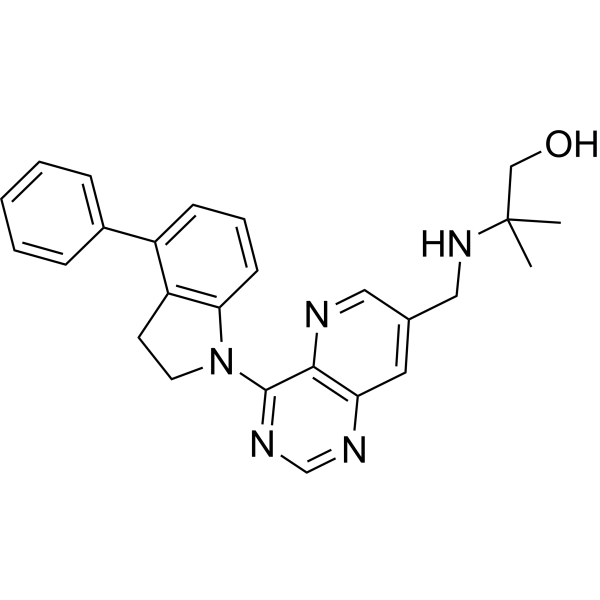
-
- HY-144442
-
|
|
PD-1/PD-L1
|
Cancer
|
|
PD-1/PD-L1-IN-15 (Compound M17) is a potent inhibitor of PD-1/PD-L1 with an IC50 value of 60.1 nM. PD-1/PD-L1-IN-15 has the potential for the research of tumor immunoresearch [1].
|
-

-
- HY-144443
-
|
|
PD-1/PD-L1
|
Cancer
|
|
PD-1/PD-L1-IN-16 (Compound M23) is a potent inhibitor of PD-1/PD-L1 with an IC50 value of 53.2 nM. PD-1/PD-L1-IN-16 has the potential for the research of tumor immunoresearch [1].
|
-
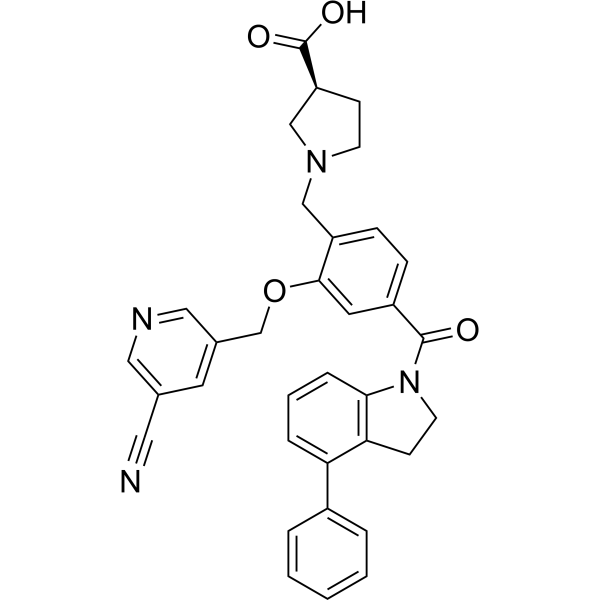
-
- HY-132192
-
|
|
PD-1/PD-L1
|
Cancer
|
|
PD-1/PD-L1-IN-9 is a potent and orally active inhibitor of PD-1/PD-L1 interaction, with an IC50 of 3.8 nM. PD-1/PD-L1-IN-9 can enhance the killing activity of tumor cells by immune cells. PD-1/PD-L1-IN-9 also exhibits significant in vivo antitumor activity in a CT26 mouse model [1].
|
-
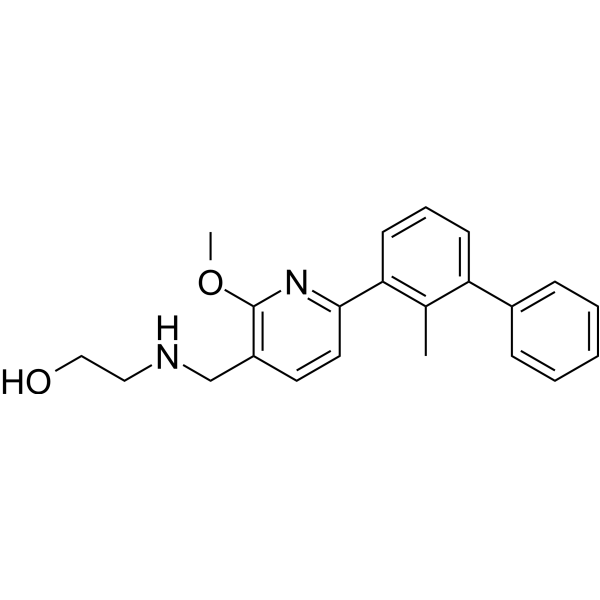
-
- HY-132192A
-
|
|
PD-1/PD-L1
|
Cancer
|
|
PD-1/PD-L1-IN-9 hydrochloride is a potent and orally active inhibitor of PD-1/PD-L1 interaction, with an IC50 of 3.8 nM. PD-1/PD-L1-IN-9 hydrochloride can enhance the killing activity of tumor cells by immune cells. PD-1/PD-L1-IN-9 hydrochloride also exhibits significant in vivo antitumor activity in a CT26 mouse model [1].
|
-
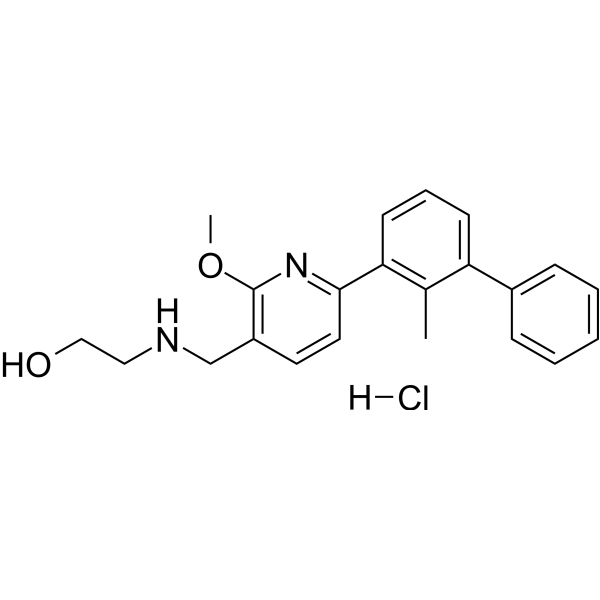
-
- HY-103048
-
|
|
PD-1/PD-L1
|
Cancer
|
|
PD-1/PD-L1-IN 3, a macrocyclic peptide, is a potent and selective inhibitor of the PD-1/PD-L1 and CD80/PD-L1 interactions extracted from patent WO2014151634A1, compound No.1. PD-1/PD-L1-IN 3 interferes with PD-L1 binding to PD-1 and CD80 by binding to PD-L1, with IC50s of 5.60 nM and 7.04 nM, respectively. PD-1/PD-L1-IN 3 can be used for the research of various diseases, including cancer and infectious diseases [1].
|
-
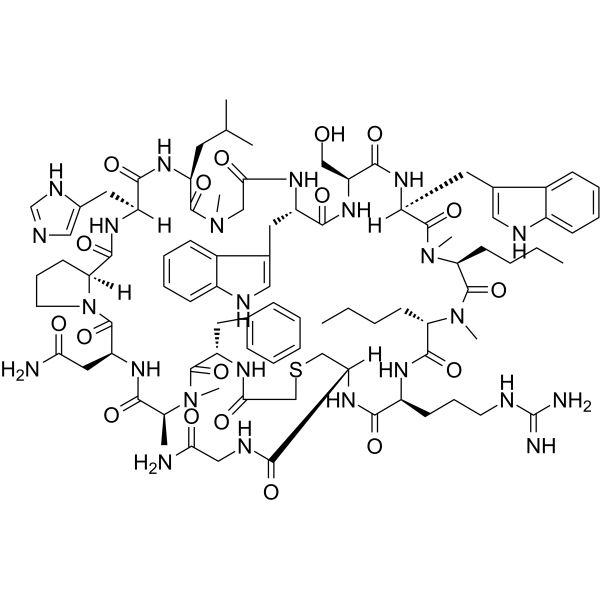
-
- HY-103048A
-
|
|
PD-1/PD-L1
|
Cancer
|
|
PD-1/PD-L1-IN 3 TFA, a macrocyclic peptide, is a potent and selective inhibitor of the PD-1/PD-L1 and CD80/PD-L1 interactions extracted from patent WO2014151634A1, compound No.1. PD-1/PD-L1-IN 3 TFA interferes with PD-L1 binding to PD-1 and CD80 by binding to PD-L1, with IC50s of 5.60 nM and 7.04 nM, respectively. PD-1/PD-L1-IN 3 TFA can be used for the research of various diseases, including cancer and infectious diseases [1].
|
-
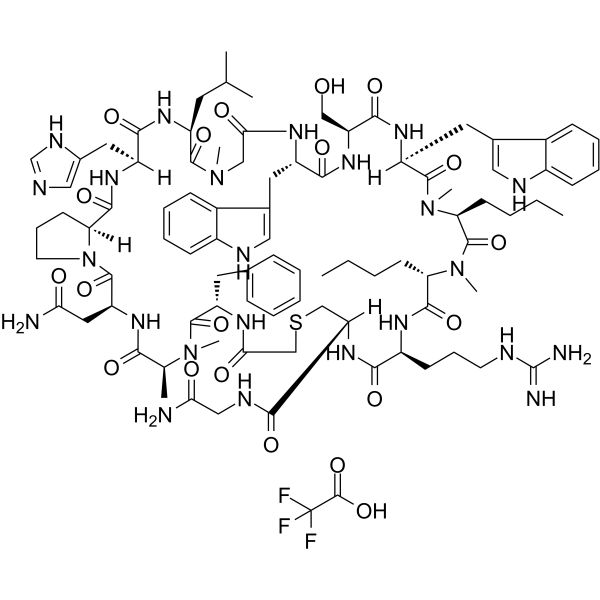
-
- HY-144746
-
|
|
PD-1/PD-L1
|
Cancer
|
|
PD-1/PD-L1-IN-26 (Compound II-14) is a potent inhibitor of PD-1/PD-L1 with an IC50 of 0.0380 μM. PD-1/PD-L1-IN-26 activates the immune microenvironment by promoting the infiltration of CD4+ T cells into tumor tissues. PD-1/PD-L1-IN-26 has the potential for the research of cancer diseases [1].
|
-
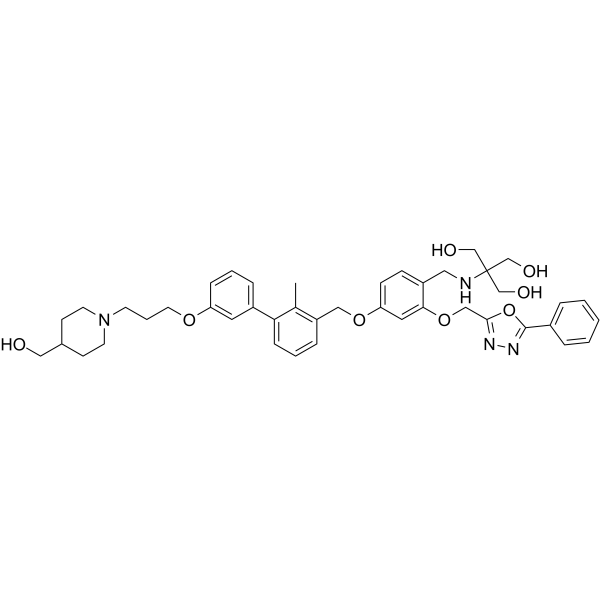
-
- HY-153064
-
|
pd-1/pd-L1-IN-30
|
PD-1/PD-L1
|
Cancer
|
|
MAX-10181 (PD-1/PD-L1-IN-30) is a PD-1/PD-L1 binding inhibitor, with an IC50 value of 0.018 μM. MAX-10181 can be used for research of cancers and other related diseases [1].
|
-
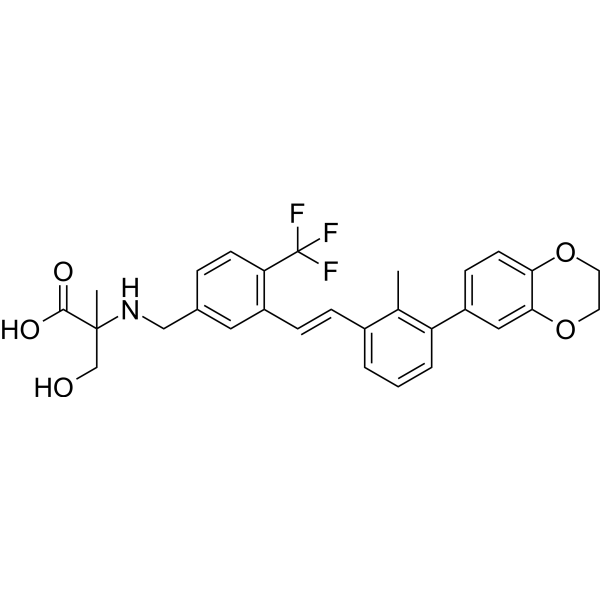
-
- HY-129172
-
-

-
- HY-145774
-
|
|
PD-1/PD-L1
|
Cancer
|
|
PD-1/PD-L1-IN-23 is a potent and orally active inhibitor of PD-1/PD-L1. PD-1/PD-L1-IN-23 is an ester proagent of L7. L7 is a benzo[c][1,2,5]oxadiazole derivative and biologically evaluated as inhibitors of PD-L1. PD-1/PD-L1-IN-23 displays significant antitumor effects in tumor models of syngeneic and PD-L1 humanized mice [1].
|
-
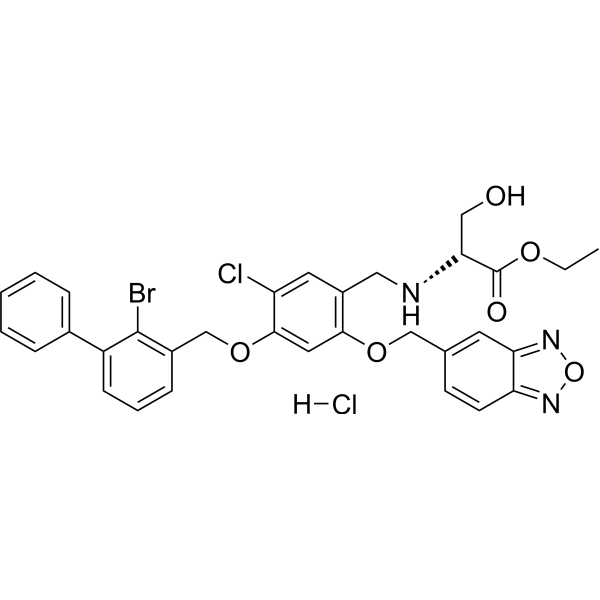
-
- HY-154869
-
|
|
PD-1/PD-L1
|
Inflammation/Immunology
Cancer
|
|
PD-1/PD-L1-IN-34 (Compound (1S,2S)-A25) inhibits PD-1/PD-L1 interaction (IC50=0.029 μM), with a selected binding affinity with PD-L1 (KD=0.1554 μM). PD-1/PD-L1-IN-34 inhibits tumor growth by activating the immune microenvironment [1].
|
-
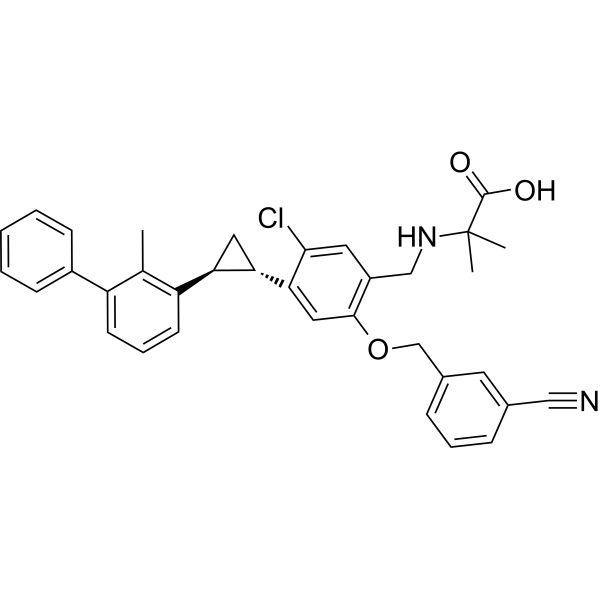
-
- HY-138407
-
|
GS-4224; pd-1/pd-L1-IN 7
|
PD-1/PD-L1
HBV
|
Infection
Cancer
|
|
Evixapodlin (GS-4224) is a human PD-1/PD-L1 protein/protein interaction inhibitor with an IC50 of 0.213 nM. Evixapodlin has anticancer and antiviral functions [1].
|
-
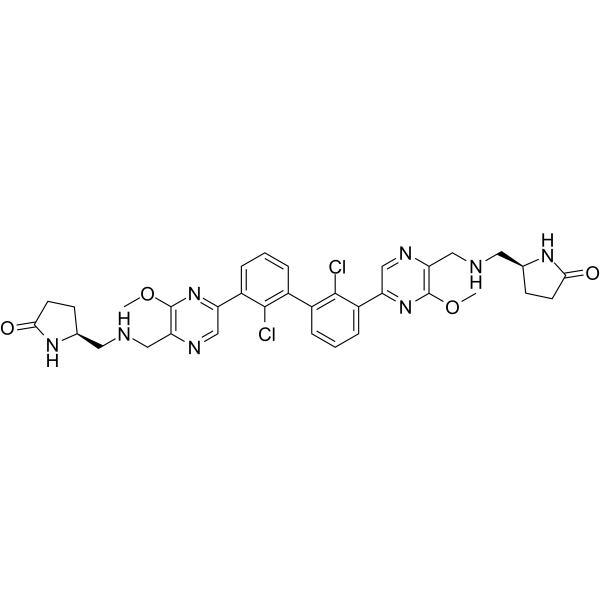
-
- HY-157055
-
|
|
PD-1/PD-L1
|
Cancer
|
|
PD-1-IN-25 (compound 43) is a potent PD-1/PD-L1 interaction inhibitor with an IC50 value of 10.2 nM in the HTRF assay. PD-1-IN-25 can promote CD8+ T cell activation through inhibiting PD-1/PD-L1 cellular signaling. PD-1-IN-25 delays the tumor growth [1].
|
-
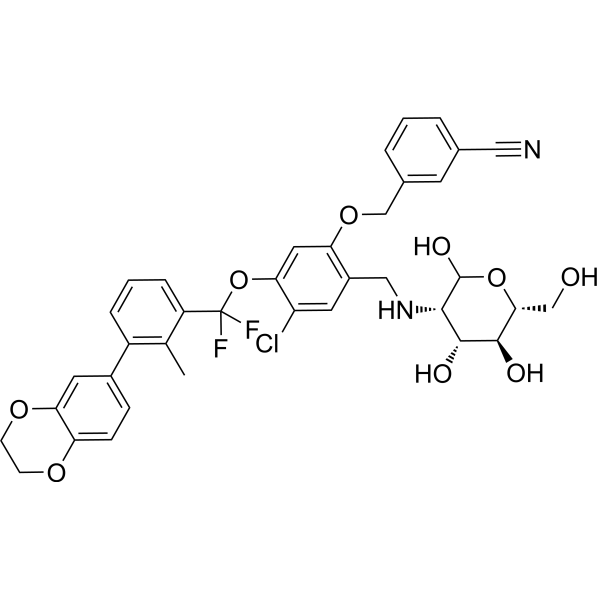
-
- HY-128605
-
|
|
PD-1/PD-L1
|
Cancer
|
|
PD-1-IN-22 is a potent programmed cell death-1 (PD-1)/programmed cell death-ligand 1 (PD-L1) interaction inhibitor with an IC50 of 92.3 nM [1].
|
-

-
- HY-130625
-
|
|
PD-1/PD-L1
|
Inflammation/Immunology
Cancer
|
|
PD-1/PD-L1-IN 6 (compound A13) is a potent PD-1/PD-L1 interaction inhibitor, with an IC50 of 132.8 nM. PD-1/PD-L1-IN 6 exhibits outstanding immunoregulatory activity. PD-1/PD-L1-IN 6 significantly elevates interferon-γ secretion in a Hep3B/OS-8/hPD-L1 and CD3 T cell co-culture model, without significant toxic effect. PD-1/PD-L1-IN 6 restores the immune response in a T cell-tumor co-culture model [1].
|
-

-
- HY-129172A
-
-
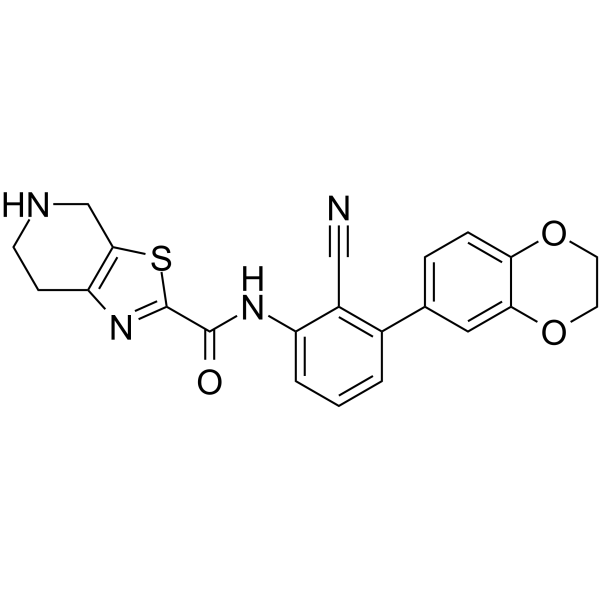
-
- HY-145770
-
|
|
PD-1/PD-L1
|
Cancer
|
|
PD-1/PD-L1-IN-19 (Example 22) is a small-molecule inhibitor of the PD-1/PD-L1 protein-protein interaction. PD-1/PD-L1-IN-19 blocks PD-1/PD-L1 with the IC50 of 62.3 nM. PD-1/PD-L1-IN-19 can be used for the research of cancers, infectious diseases and autoimmune diseases [1].
|
-
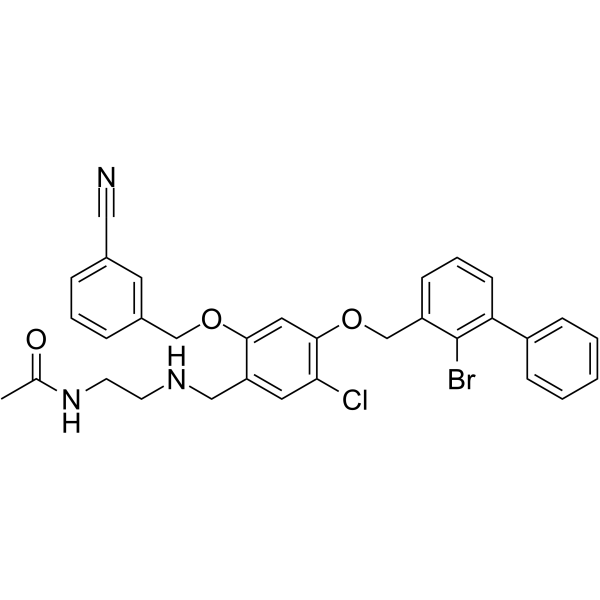
-
- HY-145771
-
|
|
PD-1/PD-L1
|
Cancer
|
|
PD-1/PD-L1-IN-20 (Example 21) is a small-molecule inhibitor of the PD-1/PD-L1 protein-protein interaction. PD-1/PD-L1-IN-20 blocks PD-1/PD-L1 with the IC50 of 5.29 nM. PD-1/PD-L1-IN-20 can be used for the research of cancers, infectious diseases and autoimmune diseases [1].
|
-

-
- HY-145772
-
|
|
PD-1/PD-L1
|
Cancer
|
|
PD-1/PD-L1-IN-21 (Example 22) is a small-molecule inhibitor of the PD-1/PD-L1 protein-protein interaction. PD-1/PD-L1-IN-21 blocks PD-1/PD-L1 with the IC50 of 4.99 μM. PD-1/PD-L1-IN-21 can be used for the research of cancers, infectious diseases and autoimmune diseases [1].
|
-
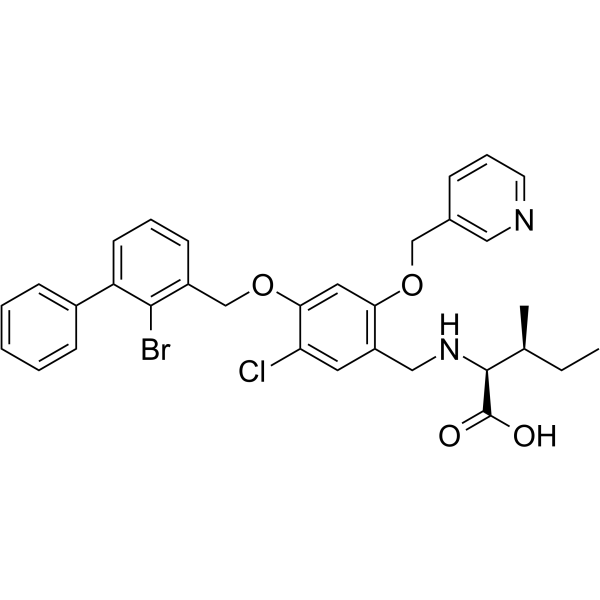
-
- HY-145773
-
|
|
PD-1/PD-L1
|
Cancer
|
|
PD-1/PD-L1-IN-22 (Example 2) is a small-molecule inhibitor of the PD-1/PD-L1 protein-protein interaction. PD-1/PD-L1-IN-22 blocks PD-1/PD-L1 with the IC50 of 0.732 μM. PD-1/PD-L1-IN-22 can be used for the research of cancers, infectious diseases and autoimmune diseases [1].
|
-
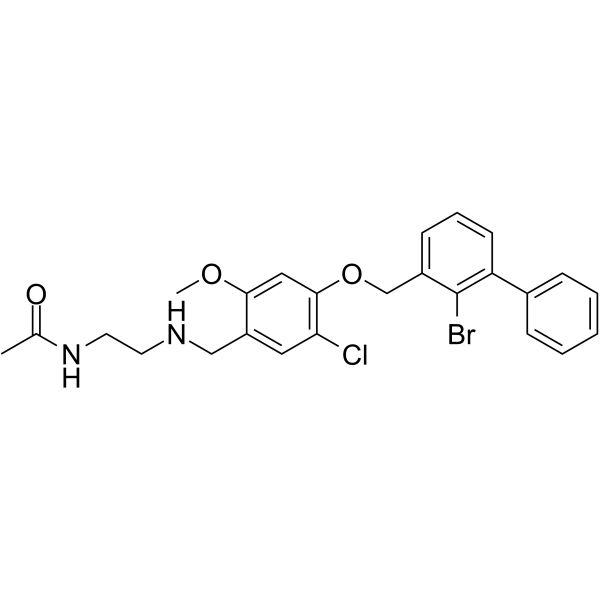
-
- HY-145768
-
|
|
PD-1/PD-L1
|
Cancer
|
|
PD-1/PD-L1-IN-18 (Compound L31) is a small-molecule inhibitor of the PD-1/PD-L1 protein-protein interaction. PD-1/PD-L1-IN-18 blocks PD-1/PD-L1 with the IC50 of 1.054 μM. Antitumor Activity [1].
|
-

-
- HY-144258
-
|
|
PD-1/PD-L1
|
Inflammation/Immunology
Cancer
|
|
PD-1/PD-L1-IN-14 (compound 17) is a bifunctional inhibitor of PD-1/PD-L1 interactions, with an IC50 of 27.8 nM. PD-1/PD-L1-IN-14 (compound 17) inhibits PD-1/PD-L1 interactions and promotes dimerization, internalization, and degradation of PD-L1 [1].
|
-
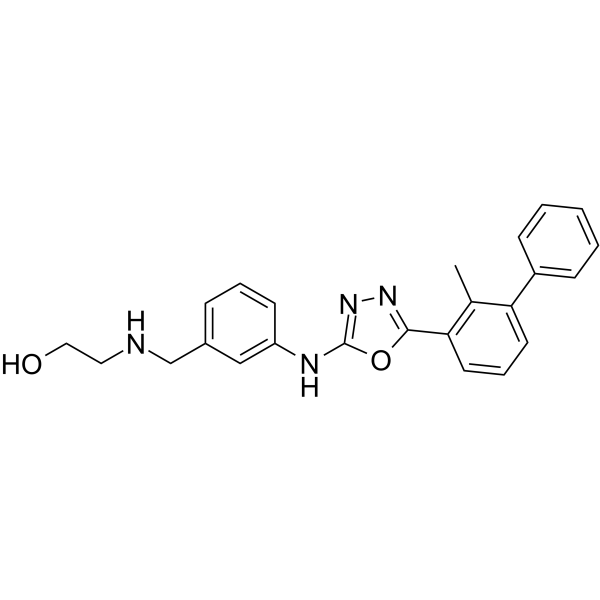
-
- HY-143305
-
|
|
PD-1/PD-L1
|
Cancer
|
|
PD-1/PD-L1-IN-25 (compound D2) is an inhibitor of PD-1/PD-L1 interaction with an IC50 value of 16.17 nM. PD-1/PD-L1-IN-25 activates the antitumor immunity of T cells efficiently in PBMCs. PD-1/PD-L1-IN-25 can be used for the research of cancer [1].
|
-

-
- HY-163041
-
-
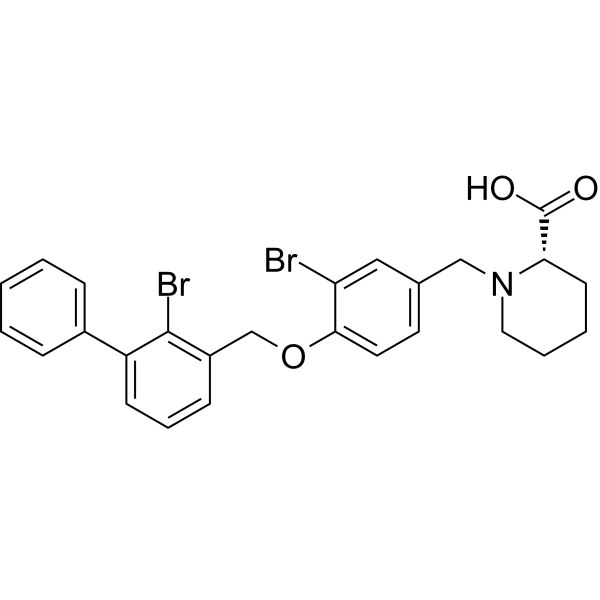
-
- HY-157811
-
|
|
PD-1/PD-L1
|
Cancer
|
|
PD-1/PD-L1-IN-40 (Compound EP16) is a PD-1/PD-L1 inhibitor. PD-1/PD-L1-IN-40 inhibits the generation of exosomal PD-L1 with IC50 = 0.108 μM. PD-1/PD-L1-IN-40 can serve as a leading compound for exosomal PD-L1 abrogation. PD-1/PD-L1-IN-40 can be used for the research of cancer [1].
|
-
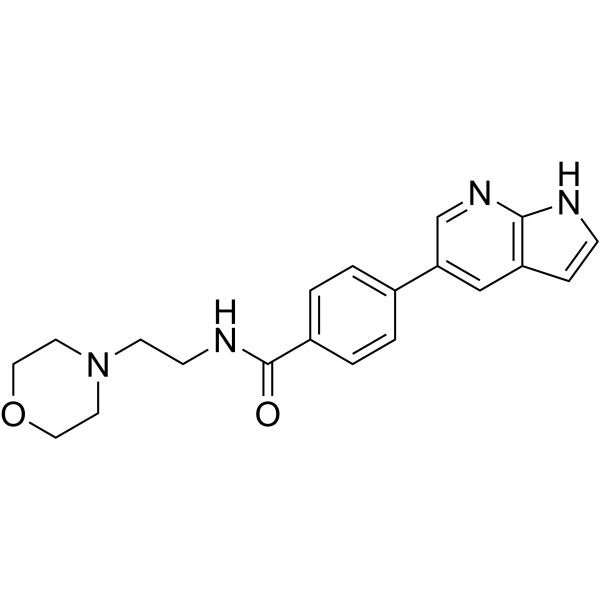
-
- HY-146740
-
|
|
PD-1/PD-L1
|
Cancer
|
|
PD-1/PD-L1-IN-27 is a potent PD-1/PD-L1 inhibitor with an IC50 value of 134 nM. PD-1/PD-L1-IN-27 shows antitumor effects with low T cell cytotoxicity. PD-1/PD-L1-IN-27 has the ability to activate CD8 + T cells and reduces T cell exhaustion [1].
|
-
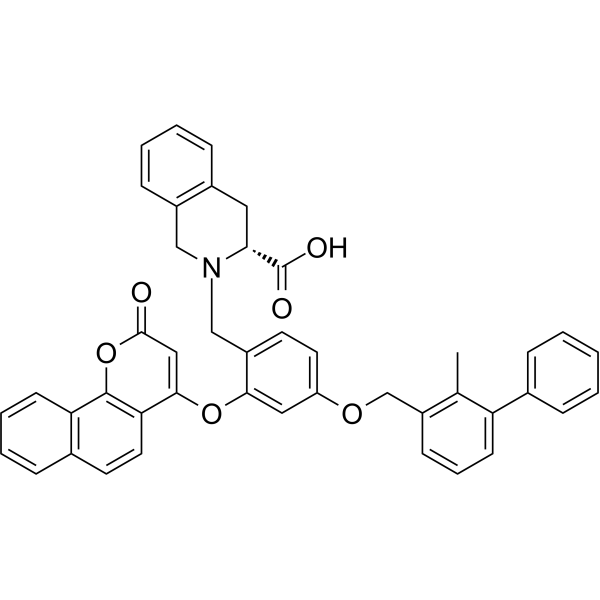
-
- HY-144649
-
|
|
PD-1/PD-L1
|
Cancer
|
|
PD-1/PD-L1-IN-24 is a highly potent PD-1/PD-L1 inhibitor with IC50 value of 1.57 nM. PD-1/PD-L1-IN-24 can restore T-cell function at the cellular level by significantly elevating the IFN-γ level. PD-1/PD-L1-IN-24 has low toxicity on the PBMCs [1].
|
-

-
- HY-152240
-
|
|
PD-1/PD-L1
|
Cancer
|
|
PD-1/PD-L1-IN-29 (S4-1) is a potent PD-1/PD-L1 inhibitor with an IC50 value of 6.1 nM. PD-1/PD-L1-IN-29 binds PD-L1 and disrupts PD-1/PD-L1 interactions, induces PD-L1 dimerization and internalization, improves its localization to the endoplasmic reticulum, and promotes PD-L1 entry into the endoplasmic reticulum. PD-1/PD-L1-IN-29 has anticancer activity [1].
|
-

-
- HY-148305
-
|
|
PD-1/PD-L1
|
Cancer
|
|
PD-1/PD-L1-IN-28 (compound 3) is an immune checkpoint inhibitor of PD-1/PD-L1 signaling pathway (IC50=0.744 µM). PD-1/PD-L1-IN-28 shows good research potential in tumor immunity [1].
|
-
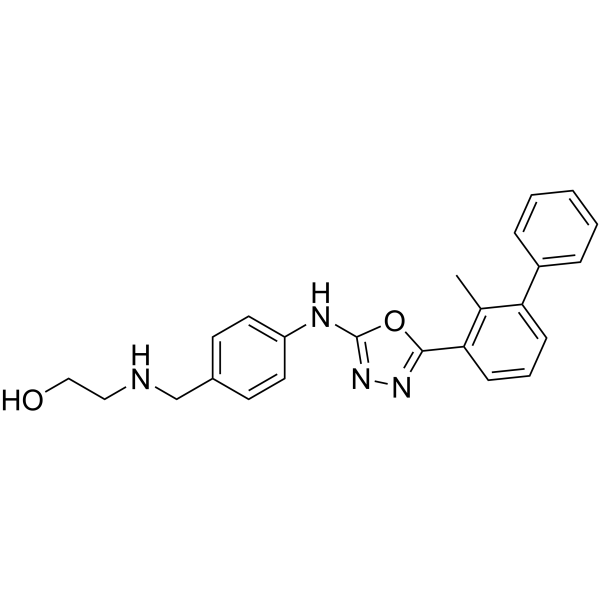
-
- HY-149356
-
|
|
PD-1/PD-L1
|
Cancer
|
|
PD-1/PD-L1-IN-31 is a PD-1/PD-L1 inhibitor (IC50=2.2 nM). PD-1/PD-L1-IN-31 promotes secretion of the IFN-γ, and induces immune activity of peripheral blood mononuclear cells (PBMCs) to inhibits tumor cells [1].
|
-
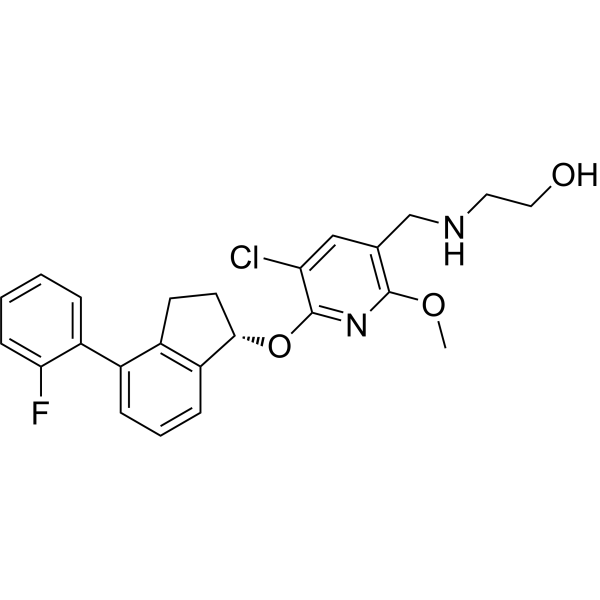
-
- HY-131347
-
|
|
PD-1/PD-L1
|
Inflammation/Immunology
Cancer
|
|
PD-1/PD-L1-IN-NP19 is a PD-1/PD-L1 inhibitor, with an IC50 of 12.5 nM for human PD-1/PD-L1 interaction. PD-1/PD-L1-IN-NP19 could activate the immune microenvironment in tumor, which may contribute to its antitumor effects [1].
|
-
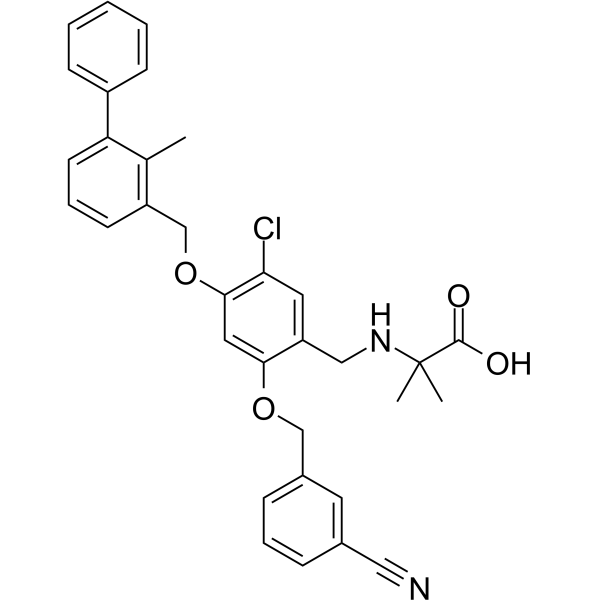
-
- HY-132202
-
|
|
PD-1/PD-L1
Apoptosis
|
Cancer
|
|
PD-1/PD-L1-IN-10 (compound B2) is an orally active PD-1/PD-L1 inhibitor (IC50 of 2.7 nM) with potent anticancer efficacy [1].
|
-

-
- HY-145239
-
|
|
PD-1/PD-L1
|
Cancer
|
|
PD-1/PD-L1-IN-13 (Compound 43) is a potent immune checkpoint PD-1/PD-L1 inhibitor with an IC50 value of 10.2 nM. PD-1/PD-L1-IN-13 promots CD8 + T cell activation and delays the tumor growth in the Hepa1-6 syngeneic mouse model [1].
|
-

-
- HY-155740
-
|
|
PD-1/PD-L1
|
Cancer
|
|
PD-1/PD-L1-IN-32 (compound A56) is a potent PD-1/PD-L1 inhibitor (IC50=2.4 nM), with anticancer activity. PD-1/PD-L1-IN-32 significantly inhibits tumor growth in hPD-L1 MC38 humanized mouse model, without obvious toxicity against mouse normal ability [1].
|
-

-
- HY-W457085
-
|
|
PD-1/PD-L1
|
Cancer
|
|
PD-1/PD-L1-IN-29 intermediate-2 is an intermediate of PD-1/PD-L1 inhibitors and can be used to synthesize Antibody-Drug Conjugates (ADCs).
|
-
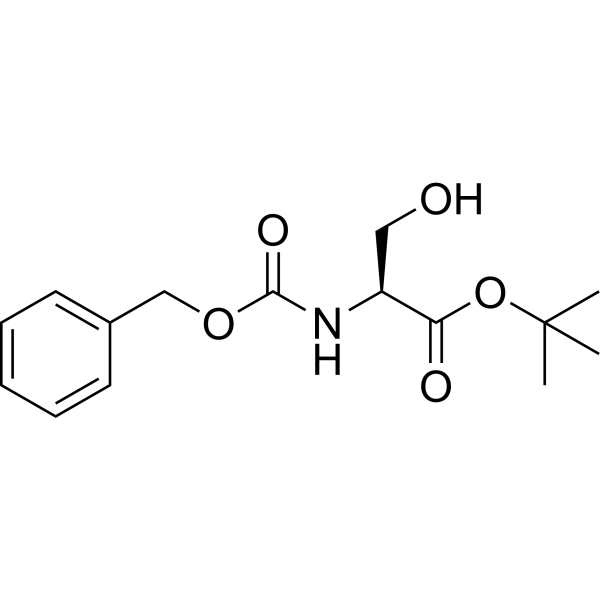
-
- HY-48934
-
|
|
PD-1/PD-L1
|
Cancer
|
|
PD-1/PD-L1-IN-29 intermediate-1 is an intermediate of PD-1/PD-L1 inhibitors and can be used to synthesize Antibody-Drug Conjugates (ADCs).
|
-
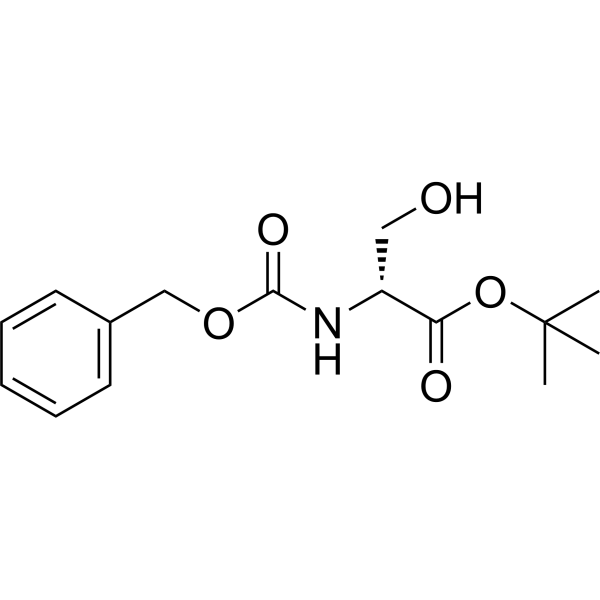
-
- HY-19991
-
-
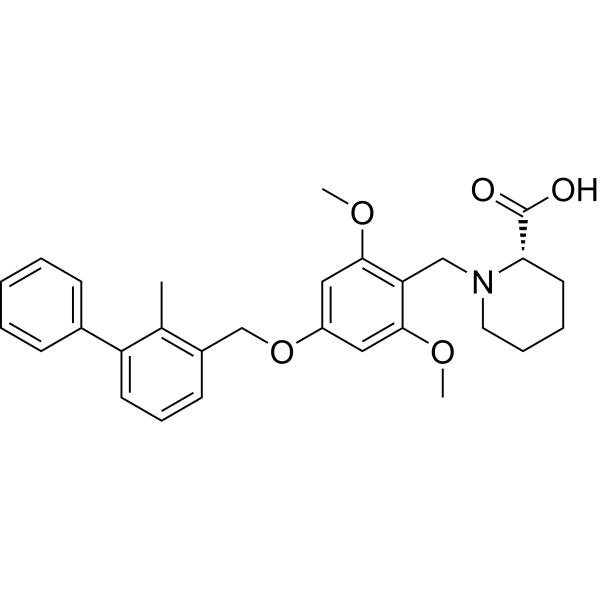
-
- HY-134884
-
|
pd-1/pd-L1-IN-8
|
PD-1/PD-L1
|
Cancer
|
|
INCB086550 is a potent, oral, small-molecule PD-L1 inhibitor with IC50s value of 3.1, 4.9 and 1.9 nM for human, cynomolgus, and rat, respectively. INCB086550 promotes the dimerization of cell-surface PD-L1 and induces PD-L1 entry into Golgi vesicles then traffick to the nucleus. INCB086550 can be used for multiple cancers research [1].
|
-
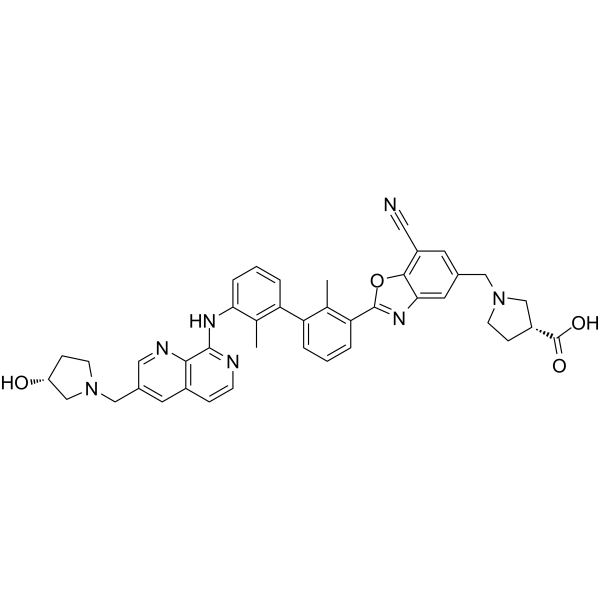
- HY-P99144
-
-
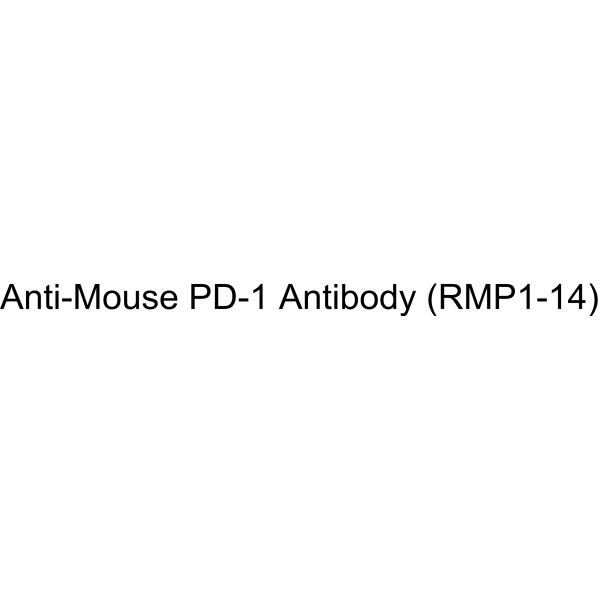
- HY-P9902A
-
|
|
PD-1/PD-L1
|
Cancer
|
|
Pembrolizumab (anti-PD-1) is a humanized IgG4 antibody and PD-1 inhibitor. Pembrolizumab produces PD-1 blockade, preventing PD-L1 and PD-L2 from connecting to PD-1. This avoids the uncontrolled regulation of T cells on cells that normally express PD-1 [1] .
|
-

- HY-P9903A
-
|
|
PD-1/PD-L1
|
Cancer
|
|
Nivolumab (anti-PD-1) is a programmed death receptor-1 (PD-1) blocking human IgG4 antibody to treat advanced (metastatic) non-small cell lung cancer [1].
|
-
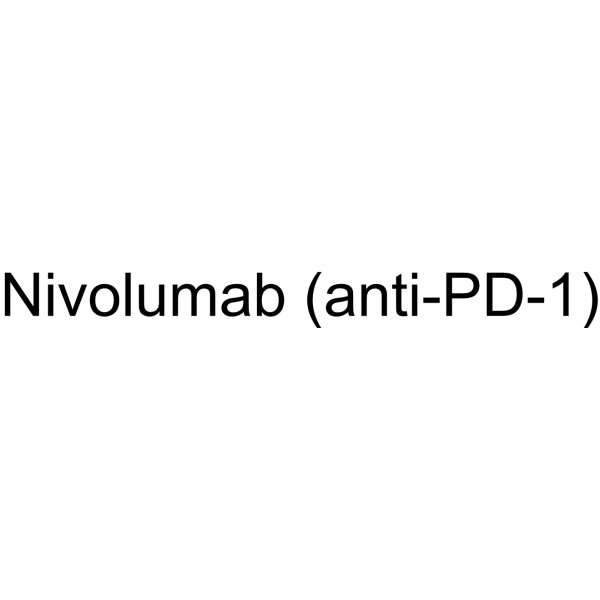
- HY-P99895
-
|
|
PD-1/PD-L1
|
Inflammation/Immunology
Cancer
|
|
Rulonilimab is a human IgG1 monoclonal antibody against PD-1 that targets, binds and inhibits PD-1 and its downstream signalling pathways with potential immune checkpoint inhibition and anti-tumour activity [1].
|
-

- HY-P99884
-
|
PF-06801591
|
PD-1/PD-L1
|
Others
|
|
Sasanlimab (PF-06801591) is a humanized IgG4-κ antibody targeting PD-1. Mainly expressed by CHO (Chinese Hamster Ovary) cells [1].
|
-

- HY-P99457
-
-

- HY-P99106
-
|
|
PD-1/PD-L1
|
Cancer
|
|
Acrixolimab a humanized IgG4-κ antibody, targeting to PD-1 [1] .
|
-

- HY-P99887
-
|
JTX-4014
|
PD-1/PD-L1
|
Cancer
|
|
Pimivalimab (JTX-4014) is a PD-1 inhibitor. Pimivalimab can be used for the research of solid tumor [1].
|
-

- HY-116274
-
|
|
PD-1/PD-L1
|
Cancer
|
|
BMS-8 inhibits the PD-1/PD-L1 interaction with IC50 of 7.2 μM. BMS-8, binds directly to PD-L1 and induces formation of PD-L1 homodimers, which in turn prevents the interaction with PD-1 [1].
|
-
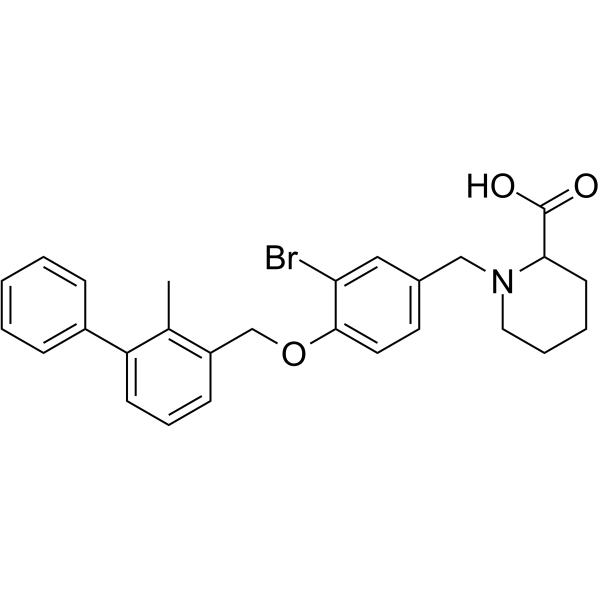
- HY-P99618
-
|
IBI-315; BH2950
|
EGFR
PD-1/PD-L1
|
Inflammation/Immunology
Cancer
|
Fidasimtamab (IBI-315; BH2950) is a recombinant human IgG1 bispecific antibody that targets, binds and inhibits both HER2 and PD-1 and their downstream signalling pathways, and links PD-1 expressing T cells to HER2 expressing tumour cells. Fidasimtamab has potential immunosuppressive and antitumor activity [1].
|
-

- HY-P9902
-
|
MK-3475; Lambrolizumab
|
PD-1/PD-L1
|
Cancer
|
|
Pembrolizumab (MK-3475) is a humanized IgG4 antibody inhibiting the programmed cell death 1 (PD-1) receptor, used in cancer immunotherapy.
|
-

- HY-P99619
-
|
SCT-I10A
|
PD-1/PD-L1
|
Cancer
|
|
Finotonlimab (SCT-I10A) is a recombinant humanised IgG PD-1 antibody. Finotonlimab has the potential for solid tumors or lymphomas research [1].
|
-

- HY-P99203
-
|
|
PD-1/PD-L1
|
Cancer
|
|
Cemiplimab (Anti-Human PD-1) is a high-affinity programmed death receptor-1 (PD-1) monoclonal IgG4 antibody that blocks PD-1/PD-L1-mediated T-cell suppression. Cemiplimab is commonly used in squamous cell skin cancer research [1] .
|
-

- HY-P2478
-
|
|
PD-1/PD-L1
|
Inflammation/Immunology
|
|
Human PD-L1 inhibitor V, a human PD-1 protein binding peptide with a Kd value of 3.32 μM. Human PD-L1 inhibitor V inhibit the interaction of hPD-1/hPD-L1 [1].
|
-
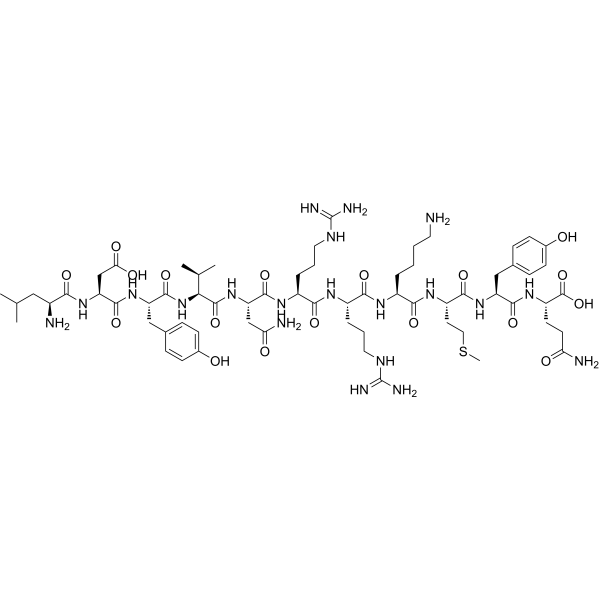
- HY-P2478A
-
|
|
PD-1/PD-L1
|
Inflammation/Immunology
|
|
Human PD-L1 inhibitor V TFA, a human PD-1 protein binding peptide with a Kd value of 3.32 μM. Human PD-L1 inhibitor V TFA inhibit the interaction of hPD-1/hPD-L1 [1].
|
-

- HY-P9978
-
|
|
PD-1/PD-L1
|
Cancer
|
|
Toripalimab is the first domestic anti-tumor PD-1 antibody in China. Toripalimab is a selective, recombinant, humanized monoclonal antibody against PD-1. Toripalimab is able to bind to PD-1 and block the interaction with its ligands. Toripalimab has exhibited primary anti-tumor effects in tumors such as melanoma, lung cancer, digestive tract tumors, hepatobiliary and pancreatic tumors, neuroendocrine neoplasms, nasopharyngeal carcinoma and urothelial carcinoma [1].
|
-

- HY-P99544
-
|
HBM-9167; KL-A167
|
PD-1/PD-L1
|
Cancer
|
|
Tagitanlimab (HBM-9167) is a humanized anti-PD-L1 antibody (IgG1κ type). Tagitanlimab selectively blocks the interaction of PD-L1 and PD-1. Tagitanlimab has the potential to be studied in recurrent or metastatic nasopharyngeal carcinoma (NPC) [1] .
|
-

- HY-P1812
-
|
NP-12
|
PD-1/PD-L1
|
Cancer
|
|
AUNP-12 (NP-12) is a peptide antagonist of the PD-1 signaling pathway, displays equipotent antagonism toward PD-L1 and PD-L2 in rescue of lymphocyte proliferation and effector functions. AUNP-12 exhibits immune activation, excellent antitumor activity, and potential for better management of immune-related adverse events (irAEs) [1].
|
-
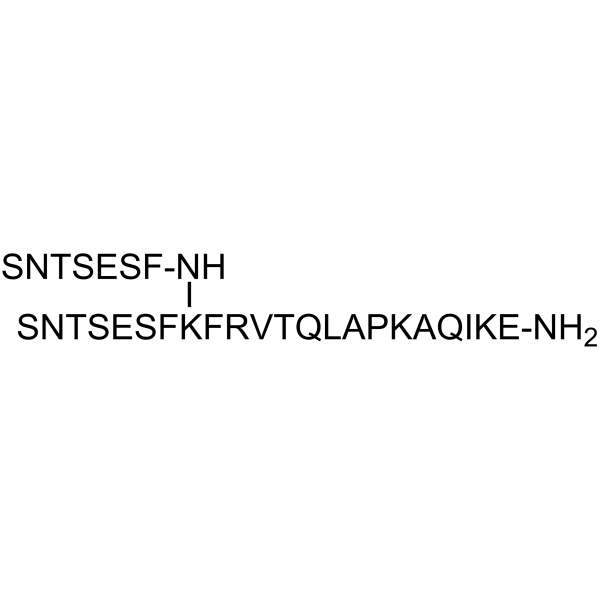
- HY-P99048
-
|
IBI308
|
PD-1/PD-L1
|
Inflammation/Immunology
Cancer
|
|
Sintilimab (IBI308) is a fully human IgG4 monoclonal antibody that binds to PD-1, thereby blocking the interaction of PD-1 with its ligands (PD-L1 and PL-L2) and consequently helping to restore the endogenous antitumour T-cell response. Sintilimab can be used for the research of classical Hodgkin's lymphoma, non-small cell lung cancer and oesophageal cancer [1].
|
-

- HY-P1812A
-
|
NP-12 TFA
|
PD-1/PD-L1
|
Cancer
|
|
AUNP-12 TFA (NP-12 TFA) is a peptide antagonist of the PD-1 signaling pathway, displays equipotent antagonism toward PD-L1 and PD-L2 in rescue of lymphocyte proliferation and effector functions. AUNP-12 TFA exhibits immune activation, excellent antitumor activity, and potential for better management of immune-related adverse events (irAEs) [1].
|
-
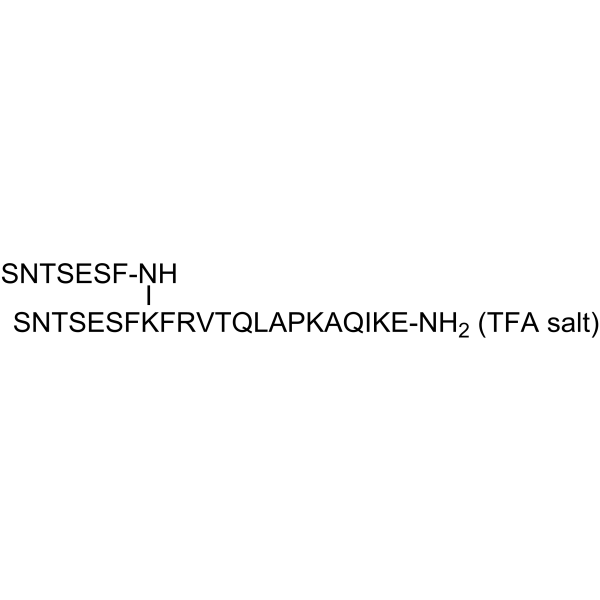
- HY-P99714
-
|
MGD019
|
PD-1/PD-L1
CTLA-4
|
Cancer
|
|
Lorigerlimab (MGD019) is a bispecific IgG4 dual-affinity re-targeting antibody (DART). Lorigerlimab can block PD-1 and CTLA-4, and improves T-cell responses. Lorigerlimab can be used for research of metastatic castration-resistant prostate cancer (mCRPC) [1] .
|
-

- HY-P9972
-
|
pdR001
|
PD-1/PD-L1
|
Cancer
|
|
Spartalizumab (PDR001) is a humanized immunoglobulin 4 monoclonal antibody that binds PD-1 with subnanomolar activity and blocks interaction with PD-L1 and PD-L2. Spartalizumab can be used for the research of anaplastic thyroid carcinoma (ATC) [1].
|
-

- HY-P99833
-
|
CK-301; TG-1501
|
PD-1/PD-L1
|
Cancer
|
|
Cosibelimab (CK-301; TG-1501) is a high-affinity, fully human PD-L1-blocking monoclonal antibody that binds PD-L1 and blocks its interaction with PD-1. Cosibelimab has a functional Fc domain and is capable of inducing ADCC and complement-dependent cytotoxicity (CDC)-mediated killing of PD-L1 + cell lines, including lymphoma cells [1].
|
-

- HY-P99687
-
|
AMG 256
|
PD-1/PD-L1
|
Cancer
|
|
Latikafusp (AMG 256) is a bifunctional fusion protein comprising a PD-1-targeting antibody and IL-21 mutein designed to deliver IL-21 pathway stimulation to PD-1+ cells. Latikafusp is designed to prime and extend the activity of cytotoxic and memory T cells and induce anti-tumor immunity. Latikafusp has the potential for solid tumors research [1] .Latikafusp may lead to the development of immunogenicity-mediated responses .
|
-

- HY-P99052
-
|
|
PD-1/PD-L1
|
Inflammation/Immunology
Cancer
|
|
Tislelizumab, a monoclonal antibody with high binding affinity to the PD-1 receptor, minimizes Fcγ receptor binding on macrophages, thereby abrogating antibody-dependent phagocytosis, a mechanism of T cell clearance and potential resistance to anti-PD-1 research. Tislelizumab can be used for the research of advanced squamous non-small-cell lung cancer [1].
|
-

- HY-P99166
-
|
|
PD-1/PD-L1
CTLA-4
|
Inflammation/Immunology
|
|
Vudalimab is a potent dual PD-1 and CTLA-4 inhibitor as a fully humanized bispecific monoclonal antibody. Vudalimab targets immune checkpoint receptors PD-1 and CTLA-4 and promotes tumor-selective T-cell activation [1].
|
-

- HY-P990072
-
|
|
PD-1/PD-L1
|
Cancer
|
|
Lipustobart is an IgG4-kappa, anti-PDCD1 (programmed cell death 1, PD1, PD-1, CD279) humanized monoclonal antibody. Lipustobart shows immunostimulant and antineoplastic activity [1].
|
-

- HY-P9971
-
|
SHR-1210
|
PD-1/PD-L1
|
Cancer
|
|
Camrelizumab (SHR-1210) is a potent humanied high-affinity IgG4-κ monoclonal antibody (mAb) to PD-1. Camrelizumab binds PD-1 at a high affinity of 3 nM and inhibits the binding interaction of PD-1 and PD-L1 with an IC50 of 0.70 nM. Camrelizumab acts as anti-PD-1/PD-L1 agent and can be used for cancer research, including NSCLC, ESCC, Hodgkin lymphoma, and advanced HCC et,al [1] .
|
-

- HY-P99639
-
|
APL-501; CBT-501; GB-226
|
PD-1/PD-L1
|
Cancer
|
|
Geptanolimab (CBT-501) is a humanized IgG4k monoclonal antibody against programmed death-1 (PD-1). Siplizumab inhibits the binding of PD-L1/L2 to PD-1 through a competitive action. Siplizumab can be used in research of cancer [1].
|
-
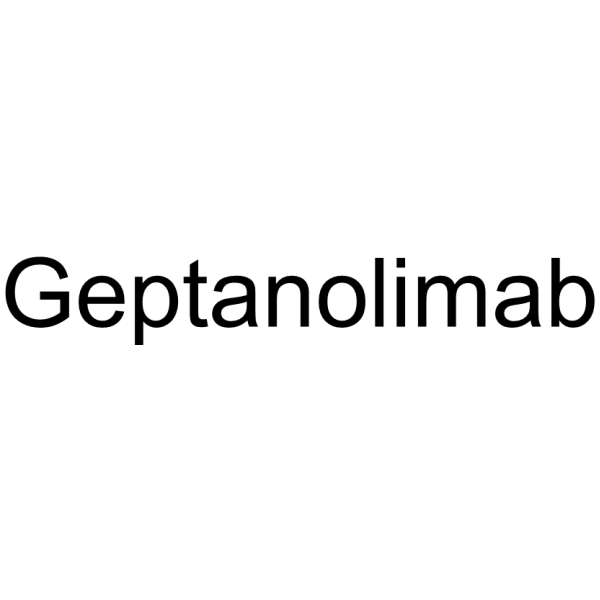
- HY-P99499
-
|
JNJ 63723283; JNJ 3283
|
PD-1/PD-L1
Interleukin Related
TNF Receptor
|
Cancer
|
|
Cetrelimab (JNJ 63723283; JNJ 3283) is a human IgG4κ mAb targeting PD-1. Cetrelimab binds PD-1 (Kd=1.72 nM, HEK293) to block the interaction of PD-1 with PD-L1 and PD-L2 (IC50s=111.7 ng/mL and 138.6 ng/mL, respectively). Cetrelimab stimulates peripheral T cells, increases IFN-γ, IL-2, TNF-α level and inhibits tumor growth in vivo [1].
|
-
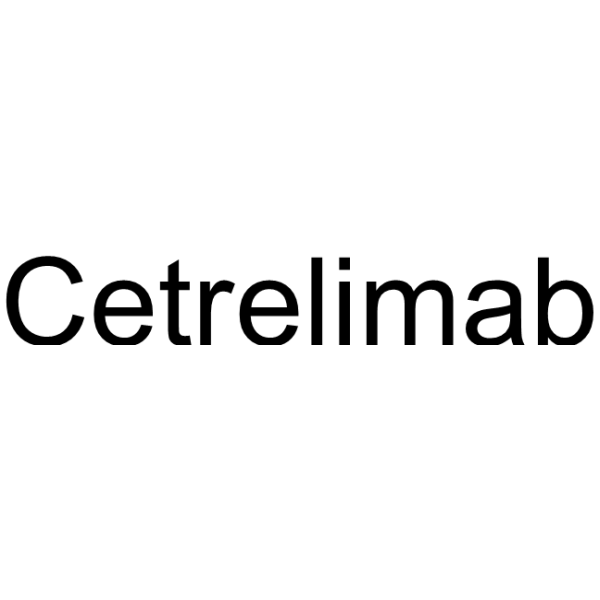
- HY-P9997
-
|
ANB030
|
PD-1/PD-L1
|
Cancer
|
|
Rosnilimab is a humanized IgG1-κ antibody targeting to PD-1 [1] .
|
-

- HY-P99957
-
|
AMG-404
|
PD-1/PD-L1
|
Cancer
|
|
Zeluvalimab (AMG-404) is a monoclonal antibody targeting the PD-1 receptor that can be used for the research of cancer [1].
|
-

- HY-P99679
-
-

- HY-P990029
-
|
|
PD-1/PD-L1
|
Infection
Cancer
|
|
Eciskafusp alfa is a programmed cell death 1 (PDCD1, best known as PD-1) cis-targeted IL2v immunocytokine. Eciskafusp alfa preferentially targets antigen-specific stem-like PD-1+ TCF-1+ CD8+ T cells and differentiates them towards a novel population of better effectors. Eciskafusp alfa can be used for the research of cancer and chronic infections [1].
|
-

- HY-P99641
-
|
|
PD-1/PD-L1
|
Cancer
|
|
Gilvetmab is a potent caninized antiPD-1 monoclonal antibody. gilvetmab blocks the interaction between PD-1 and its ligand PDL-1 [1].
|
-

- HY-P9903
-
|
BMS-936558; ONO-4538; MDX-1106
|
PD-1/PD-L1
|
Cancer
|
|
Nivolumab is a programmed death receptor-1 (PD-1) blocking human IgG4 antibody to treat advanced (metastatic) non-small cell lung cancer.
|
-

- HY-P99109
-
|
GLS-010; AB-122; WBP-3055
|
PD-1/PD-L1
|
Cancer
|
|
Zimberelimab (GLS-010) is a fully human IgG4 anti-PD-1 monoclonal antibody with an EC50 of 210 pM for human PD-1. Zimberelimab effectively blocks the binding of PD-L1 and PD-L2 to cell-surface PD-1 in CHO-S cells, with IC50 values of 580 pM and 670 pM, respectively. Zimberelimab shows antitumor activities, and can be used for various cancers research, including cervical cancer, non-small cell lung cancer and classical Hodgkin’s lymphoma [1] .
|
-

- HY-P9993
-
|
LY-3462817
|
PD-1/PD-L1
|
Cancer
|
|
Peresolimab is a humanized IgG1-κ antibody targeting to PD-1. Peresolimab potentially stimulates physiological immune inhibitory pathways to restore immune homeostasis [1] .
|
-

- HY-155101
-
|
|
PD-1/PD-L1
|
Cancer
|
|
PD-L1-IN-3 (Compound 4a) is a compound that targets PD-1/PD-L1, the IC50 value and EC50 value is 4.97nM and 2.70 μM for inhibit PD-L1 and Jurkat T cells, respectively. PD-L1-IN-3 can bind PD-L1 dimer to prevent PD-1 binding to PD-L1, therefore blocking PD-1 signaling. PD-L1-IN-3 can be used for lung cancer and melanoma diseases research [1].
|
-

- HY-P4072
-
|
|
PD-1/PD-L1
|
Cancer
|
|
(D)-PPA 1 is a hydrolysisresistant d-peptide antagonist. (D)-PPA 1 serves as a potent PD-1/PD-L1 inhibitor. (D)-PPA 1 binds to PD-1 with the affinity 0f 0.51 μM with in vitro and in vivo efficacy [1].
|
-

- HY-P4072A
-
|
|
PD-1/PD-L1
|
Cancer
|
|
(D)-PPA 1 TFA is a hydrolysisresistant d-peptide antagonist. (D)-PPA 1 TFA serves as a potent PD-1/PD-L1 inhibitor. (D)-PPA 1 TFA binds to PD-1 with the affinity 0f 0.51 μM with in vitro and in vivo efficacy [1].
|
-
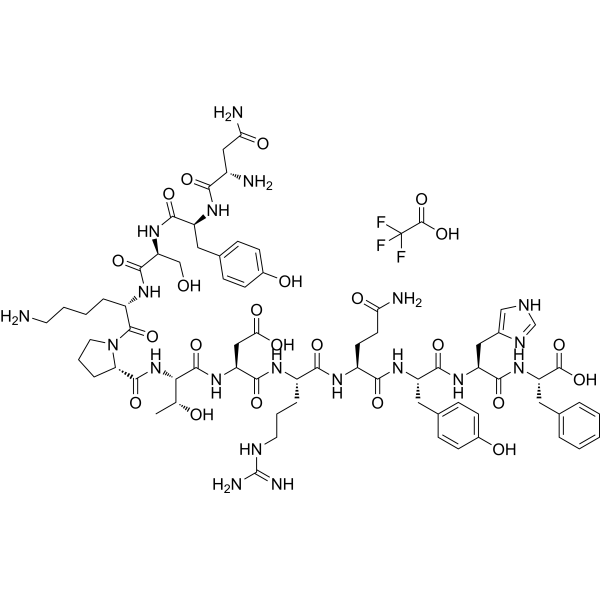
- HY-P99117
-
|
AK104
|
PD-1/PD-L1
|
Cancer
|
|
Cadonilimab (AK104) is a targeting PD1/CTLA4 IgG1 scaffold Fc-engineered humanized antibody. Cadonilimab can be used for researching metastatic cervical cancer [1] .
|
-

- HY-131183
-
|
|
PROTACs
PD-1/PD-L1
|
Inflammation/Immunology
|
|
PROTAC PD-1/PD-L1 degrader-1, a PD-1/PD-L1 PROTAC based on Cereblon E3 ligand, inhibits PD-1/PD-L1 interaction with an IC50 of 39.2 nM. PROTAC PD-1/PD-L1 degrader-1 significantly restores the immunity repressed in a co-culture model of Hep3B/OS-8/hPD-L1 and CD3 T cells. PROTAC PD-1/PD-L1 degrader-1 moderately reduces the protein levels of PD-L1 in a lysosome-dependent manner [1].
|
-
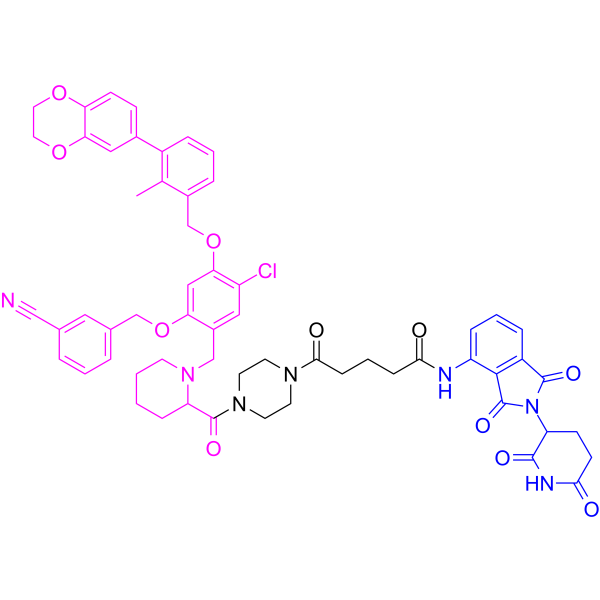
- HY-160585
-
|
|
PD-1/PD-L1
|
Inflammation/Immunology
Cancer
|
|
PD-L1/PD-1-IN-1 (compound 8j) is a potent inhibitor of PD-L1/PD interaction, with IC50 < 1 nM. PD-L1/PD-1-IN-1 plays an important role in anti-tumor research [1].
|
-

- HY-102011
-
|
|
PD-1/PD-L1
|
Inflammation/Immunology
Cancer
|
|
BMS-1166 is a potent PD-1/PD-L1 immune checkpoint inhibitor. BMS-1166 induces dimerization of PD-L1 and blocks its interaction with PD-1, with an IC50 of 1.4 nM. BMS-1166 antagonizes the inhibitory effect of PD-1/PD-L1 immune checkpoint on T cell activation [1] .
|
-

- HY-102011A
-
|
|
PD-1/PD-L1
|
Inflammation/Immunology
Cancer
|
|
BMS-1166 hydrochloride is a potent PD-1/PD-L1 immune checkpoint inhibitor. BMS-1166 hydrochloride induces dimerization of PD-L1 and blocks its interaction with PD-1, with an IC50 of 1.4 nM. BMS-1166 hydrochloride antagonizes the inhibitory effect of PD-1/PD-L1 immune checkpoint on T cell activation [1] .
|
-
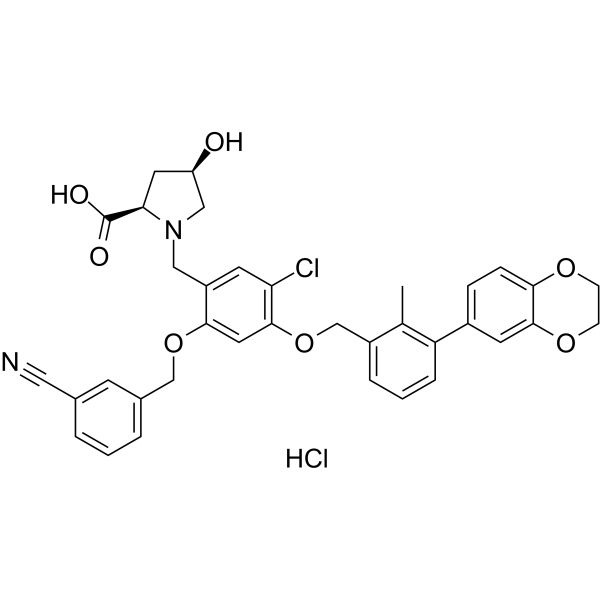
- HY-P99489
-
|
ABBV 181; PR 1648817
|
PD-1/PD-L1
|
Cancer
|
|
Budigalimab (ABBV 181; PR 1648817) is a humanized IgG1 monoclonal antibody targeting programmed cell death 1 (PD-1) receptor. Budigalimab is Fc mutated thus to reduce Fc receptor interactions and limit effector function [1].
|
-

- HY-P99610
-
|
BI-754091
|
PD-1/PD-L1
|
Cancer
|
|
Ezabenlimab (BI-754091) is an anti-PD-1 mAb with binding constant Kd value of 6 nM (CHO cells). Ezabenlimab blocks the interaction of PD-1 with PD-L1 and PD-L2. Ezabenlimab increases interferon-γ secretion in T cells, and inhibits tumor growth in vivo [1].
|
-

- HY-P99345
-
|
TSR-042
|
PD-1/PD-L1
|
Cancer
|
|
Dostarlimab (TSR-042) is a humanized anti-PD-1 monoclonal antibody. Dostarlimab binds with high affinity to human PD-1 and competitively inhibits its interaction with its ligands, PD-L1 and PD-L2, with IC50s of 1.8 and 1.5 nM, respectively [1].
|
-
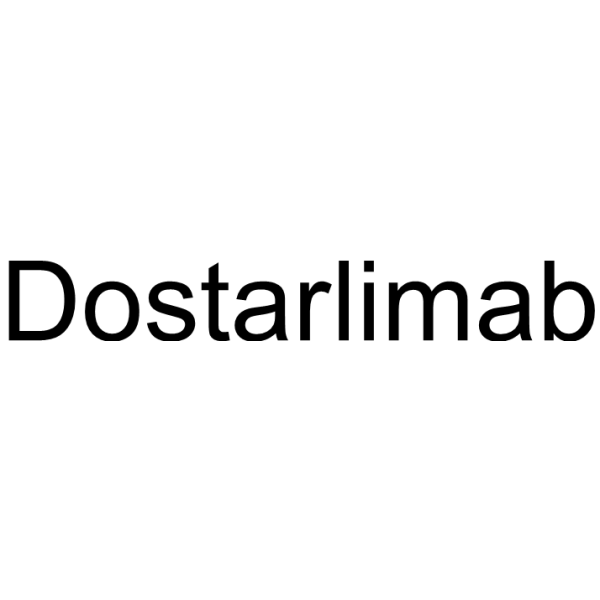
- HY-19745
-
|
|
PD-1/PD-L1
Apoptosis
|
Cancer
|
|
BMS-202 is a potent and nonpeptidic PD-1/PD-L1 complex inhibitor with an IC50 of 18 nM and a KD of 8 μM. BMS-202 binds to PD-L1 and blocks human PD-1/PD-L1 interaction. BMS-202 has antitumor activity [1] .
|
-
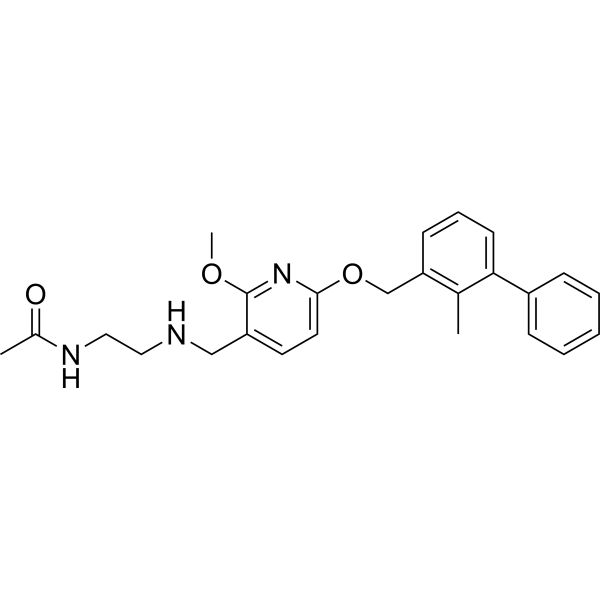
- HY-P99633
-
|
BGB-A333
|
PD-1/PD-L1
Apoptosis
|
Cancer
|
|
Garivulimab (BGB-A333) is a humanized IgG1-variant monoclonal antibody that specifically targets and binds to PD-L1. Garivulimab selectively blocks the interaction of PD-L1 and PD-1. Garivulimab has antitumor activity [1].
|
-

- HY-P9919
-
|
MEDI 4736
|
PD-1/PD-L1
|
Cancer
|
|
Durvalumab (MEDI 4736) is an human anti-PD-L1 monoclonal antibody [1]. Durvalumab (MEDI4736) completely blocks the binding of PD-L1 to both PD-1 and CD80, with IC50s of 0.1 and 0.04 nM, respectively .
|
-

- HY-P2477
-
|
|
PD-1/PD-L1
|
Inflammation/Immunology
|
|
Human PD-L1 inhibitor IV, a polypeptide, is a competitive human PD-1 protein inhibitor with a Kd value of 1.38 μM. Human PD-L1 inhibitor IV inhibits the interaction of hPD-1/hPD-L1 [1].
|
-

- HY-N12537A
-
|
|
Aryl Hydrocarbon Receptor
PD-1/PD-L1
|
Cancer
|
|
(2R,3S)-PD-1/PD-L1-IN-38 (Compound (±)-13e) is an orally active Ah receptor (AhR) antagonist with in vivo and in vitro anticancer activity. (2R,3S)-PD-1/PD-L1-IN-38 promotes the secretion of INF-γ by CD8 +T cells and inhibits the signal transduction of PD-1/PD-L1 [1].
|
-

- HY-W771599
-
|
APY69
|
PD-1/PD-L1
|
Cancer
|
|
ASC-69 (APY69)is a potent and promising?PD-1/PD-L1 small-molecule inhibitor [1].
|
-
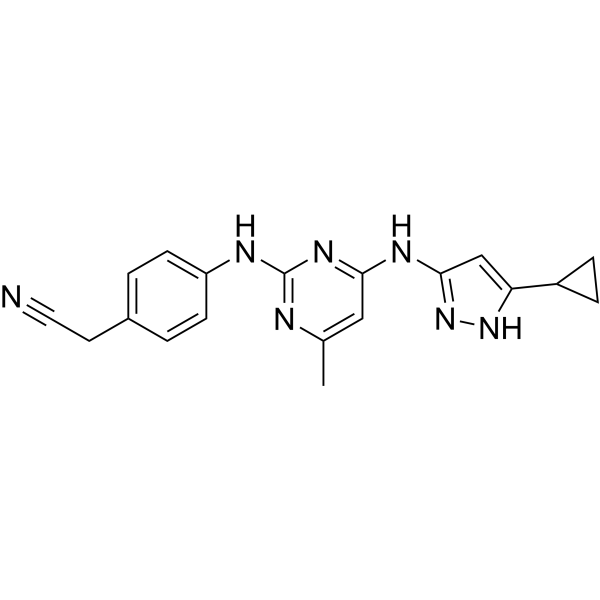
- HY-P99115
-
|
ASC 22; KN 035
|
PD-1/PD-L1
|
Cancer
|
|
Envafolimab (ASC 22; KN 035) is a recombinant protein of a humanized single-domain anti- PD-L1 antibody. Envafolimab is created by a fusion of the of anti-PD-L1 domain with Fc fragment of human IgG1 antibody. Envafolimab blocks interaction between PD-L1 and PD-1 with an IC50 value of 5.25 nM. Envafolimab has the potential for the research of solid tumors [1] .
|
-

- HY-P99807
-
|
BCD-100
|
PD-1/PD-L1
|
Cancer
|
|
Prolgolimab (BCD-100) is a human IgG1 anti-PD-1 monoclonal antibody containing the Fc-silencing 'LALA' mutation. Prolgolimab can be used for the research of advanced melanoma [1].
|
-

- HY-P99540
-
|
PSB-205; QL1706 (iparomlimab/tuvonralimab); PBS105
|
PD-1/PD-L1
CTLA-4
|
Cancer
|
|
Tuvonralimab (PSB-205; QL1706) is a dual immune checkpoint blockade containing a mixture of anti-PD-1 IgG4 and anti-CTLA-4 IgG1 antibodies, Iparomlimab and Tuvonralimab [1].
|
-

- HY-P99675
-
|
AK112
|
PD-1/PD-L1
VEGFR
|
Cancer
|
|
Ivonescimab (AK112) is a PD-1/VEGF Bispecific Antibody. Ivonescimab can be used for cancer research [1] .
|
-

- HY-P9996
-
|
LY3434172
|
PD-1/PD-L1
|
Cancer
|
|
Reozalimab is a bispecific antibody targeting to PD-1/PD-L1. Reozalimab mediates antibody-dependent cell cytotoxicity in cancer research [1] .
|
-

- HY-19745A
-
|
|
PD-1/PD-L1
|
Cancer
|
|
N-deacetylated BMS-202 is the deacetylated of BMS-202. BMS-202 is an inhibitor of the PD-1/PD-L1 interaction, mainly used for cancer treatment.
|
-
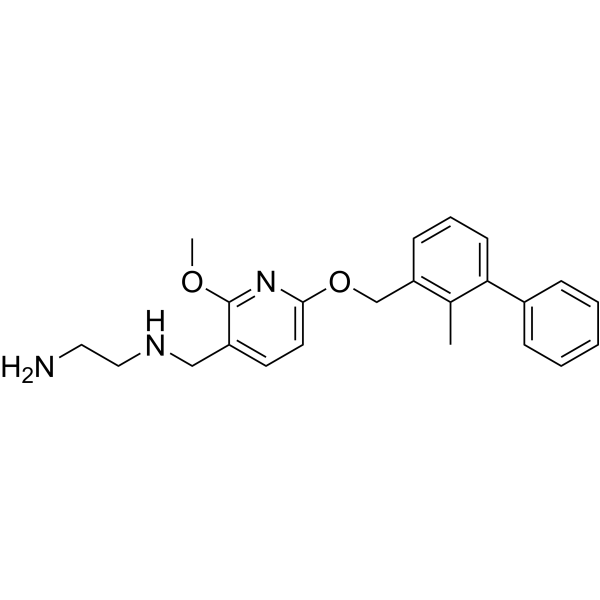
- HY-P99100
-
|
CTL-002
|
PD-1/PD-L1
|
Cancer
|
|
Visugromab is aGDF-15 neutralizing IgG4 mAb. Visugromab exhibits potent effecicacy in PD-1/PD-L1 relapsed/refractory metastatic solid tumors [1].
|
-

- HY-120402
-
-
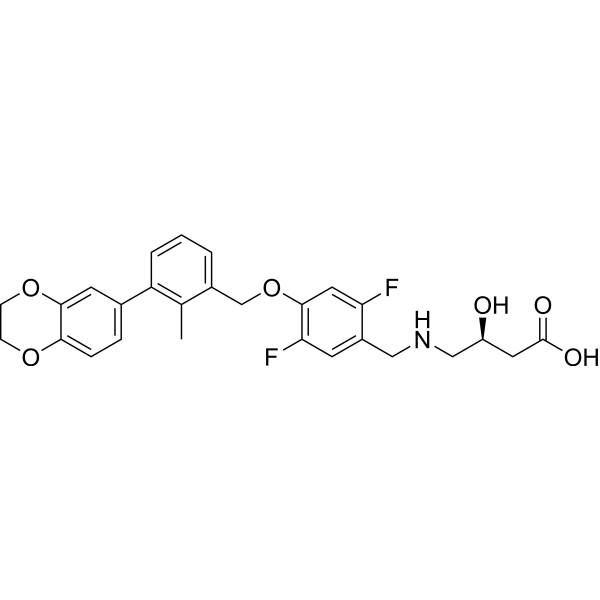
- HY-150879
-
-
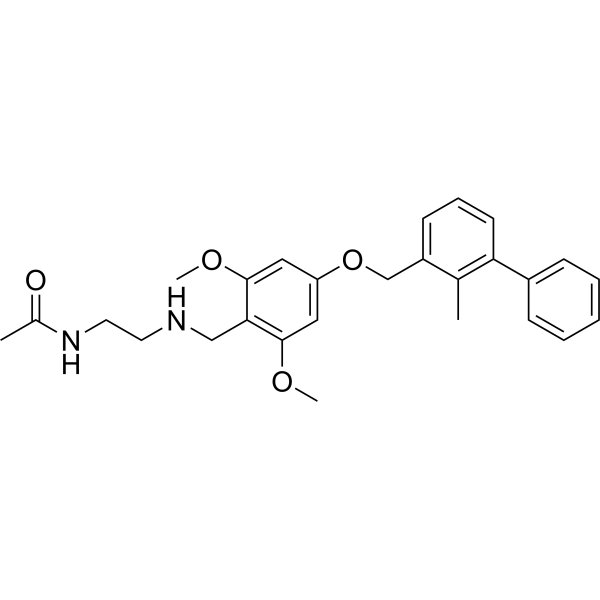
- HY-132212
-
-

- HY-132223
-
|
|
PD-1/PD-L1
|
Inflammation/Immunology
Cancer
|
|
LH1306 is a C2-symmetric inhibitor of PD-1/PD-L1 protein-protein interaction (PPI), with an IC50 value of 25 nM. LH1306 can be used in anti-tumor research [1].
|
-

- HY-P99709
-
|
LY3300054
|
PD-1/PD-L1
|
Cancer
|
|
Lodapolimab (LY3300054) is an IgGλ anti-PD-1 monoclonal antibody [1].
|
-

- HY-P99422
-
|
SHR-1316
|
PD-1/PD-L1
Apoptosis
|
Cancer
|
|
Adebrelimab (SHR-1316) is a humanized IgG4 monoclonal PD-L1 (PD-1/PD-L1) antibody. Adebrelimab has promising antitumor activity in solid tumors including extensive-stage small-cell lung cancer (SCLC) [1] .
|
-

- HY-P99108
-
-

- HY-120635
-
|
|
PD-1/PD-L1
|
Inflammation/Immunology
Cancer
|
|
BMS-1001 is an orally active human PD-L1/PD-1 immune checkpoint inhibitor. BMS-1001 exhibits low-toxicity in cells. The IC50 value of BMS-1001 in a homogeneous time-resolved fluorescence (HTRF) binding assay is 2.25 nM [1] .
|
-

- HY-120647
-
|
|
PD-1/PD-L1
|
Inflammation/Immunology
Cancer
|
|
BMS-1001 is an orally active human PD-L1/PD-1 immune checkpoint inhibitor. BMS-1001 exhibits low-toxicity in cells. The IC50 value of BMS-1001 in a homogeneous time-resolved fluorescence (HTRF) binding assay is 2.25 nM [1] .
|
-
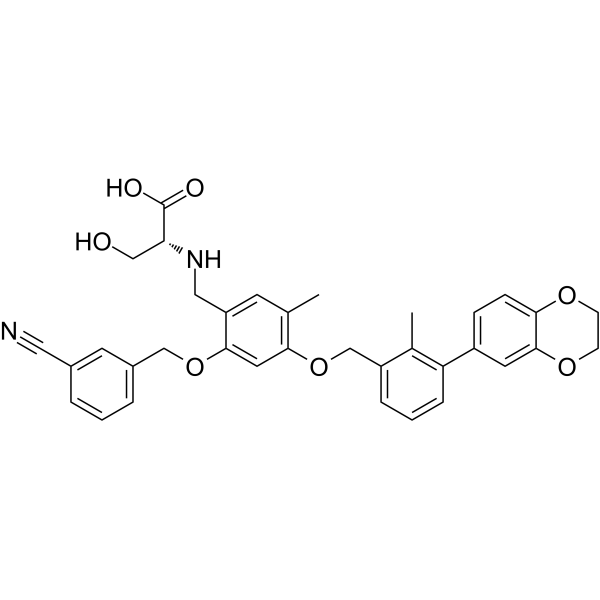
- HY-P10091
-
|
|
PD-1/PD-L1
|
Cancer
|
|
CD24/Siglec-10 blocking peptide, CSBP can not only block the interaction of CD24/Siglec-10 but also PD-1/PD-L1. CD24/Siglec-10 blocking peptide, CSBP can induce the phagocytosis of tumor cell [1].
|
-
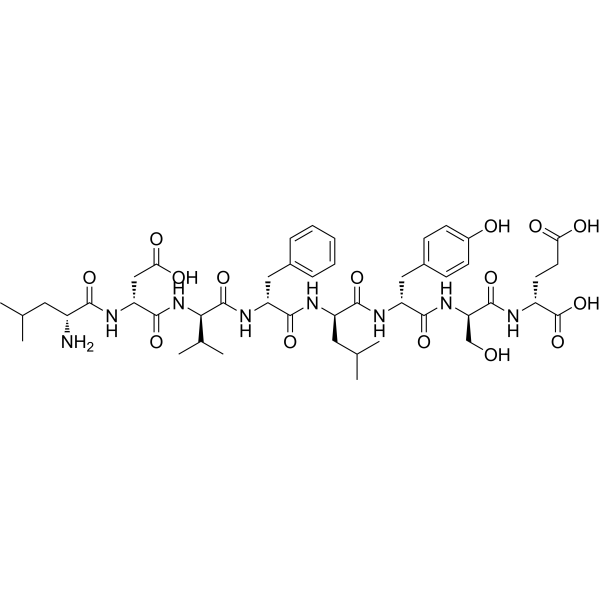
- HY-144497
-
-
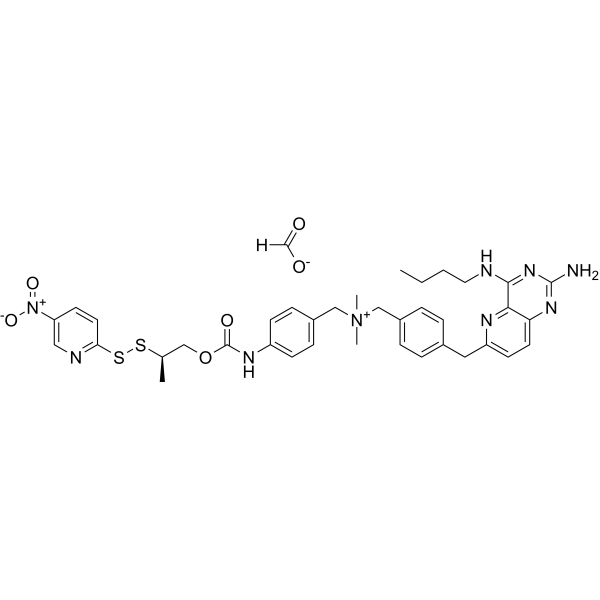
- HY-P99419
-
|
GEN1046
|
PD-1/PD-L1
|
Cancer
|
|
Acasunlimab (GEN1046) is a bispecific antibody (bsAb) targeting PD-L1 and 4-1BB. Acasunlimab enhances T-cell and NK-cell function through conditional 4-1BB stimulation while constitutively blocking the PD-1/PD-L1 inhibitory axis. Acasunlimab can be used in research of cancer [1] .
|
-

- HY-P99668
-
|
|
PD-1/PD-L1
|
Cancer
|
|
Iparomlimab is an anti-human PD-1/CD279/PDCD1 IgG4κ antibody. Iparomlimab also targets to human monoclonal PSB103 γ4-chain, disulfided with human monoclonal PSB103 κ-chain to form a dimer. Iparomlimab can be used for Oncology research [1].
|
-

- HY-P3143A
-
|
|
PD-1/PD-L1
|
Cancer
|
|
BMSpep-57 hydrochloride is a potent and competitive macrocyclic peptide inhibitor of PD-1/PD-L1 interaction with an IC50 of 7.68 nM. BMSpep-57 hydrochloride binds to PD-L1 with Kds of 19 nM and 19.88 nM in MST and SPR assays, respectively. BMSpep-57 hydrochloride facilitates T cell function by in creasing IL-2 production in PBMCs [1].
|
-
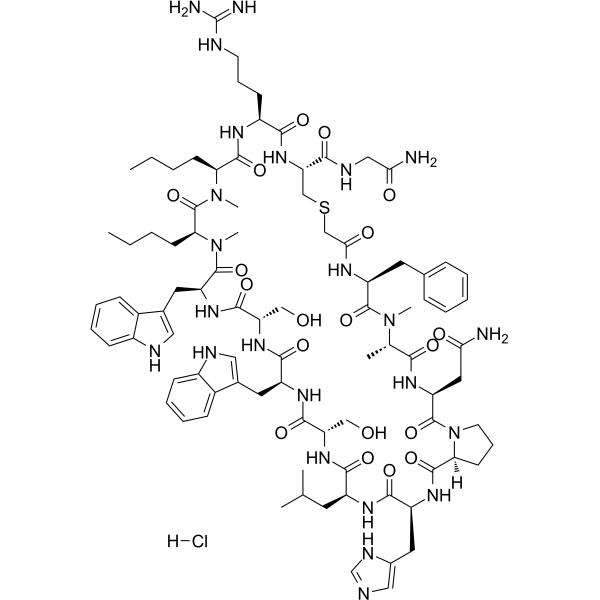
- HY-P99118
-
|
HLX 10
|
PD-1/PD-L1
|
Cancer
|
|
Serplulimab (HLX 10) is humanized monoclonal anti-PD-1 antibody. Serplulimab can be used in research of small cell lung cancer [1].
|
-

- HY-P3143
-
|
|
PD-1/PD-L1
|
Cancer
|
|
BMSpep-57 is a potent and competitive macrocyclic peptide inhibitor of PD-1/PD-L1 interaction with an IC50 of 7.68 nM. BMSpep-57 binds to PD-L1 with Kds of 19 nM and 19.88 nM in MST and SPR assays, respectively. BMSpep-57 facilitates T cell function by in creasing IL-2 production in PBMCs [1].
|
-

- HY-P99963
-
|
HS636
|
PD-1/PD-L1
|
Cancer
|
|
Sudubrilimab (HS636) is an Ig G1-kappa monoclonal antibody against PDL1. Sudubrilimab is fused at the C terminus of the heavy chain to a TGF-β1 receptor Ⅱ ectodomain (TGFBR2-ECD), and which can sequester the PD-1/PD-L1 pathway and TGF-β bioactivity in the immunosuppressive tumor microenvironment [1].
|
-

- HY-P99758
-
|
CS1003
|
PD-1/PD-L1
|
Cancer
|
|
Nofazinlimab (CS1003) is a humanised IgG4 anti-PD-1 monoclonal antibody. Nofazinlimab can be used for unresectable hepatocellular carcinoma (uHCC) research [1].
|
-

- HY-144501
-
|
|
Toll-like Receptor (TLR)
PD-1/PD-L1
|
Inflammation/Immunology
Cancer
|
|
D18 is an immune modulator. D18 acts as a TLR7/8 dual agonist (EC50=24 nM for hTLR7 and 10 nM for hTLR8, respectively). D18 increases PD-L1 expression through epigenetic regulation, thus sensitizing tumors to PD-1/PD-L1 blockade. D18 is a ADC cytotoxin uesd for the systhesis of ADC HE-S2 [1].
|
-
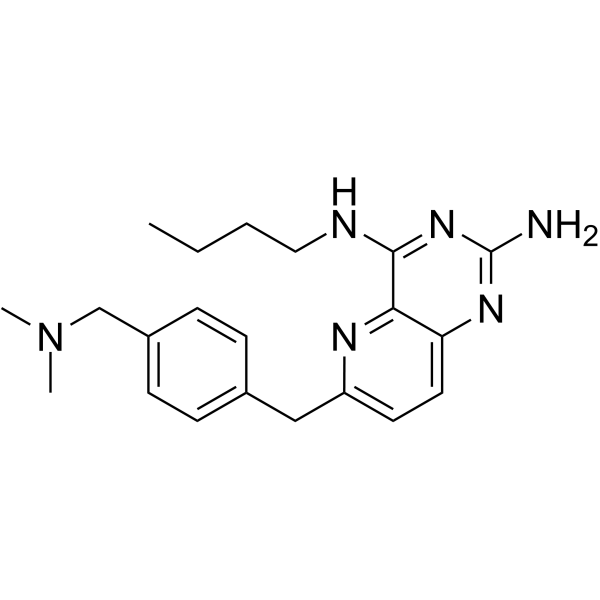
- HY-156085
-
|
|
PD-1/PD-L1
|
Cancer
|
|
LP23 is a non-arylmethylamine PD-1/PD-L1 inhibitor (IC50: 16.7 nM) with anti-tumor activity. LP23 restores immune cell function in HepG2/Jurkat T cells and promotes HepG2 cell death. LP23 is active in vivo in the B16-F10 tumor model (TGI=88.6% at 30 mg/kg) [1].
|
-

- HY-162356
-
|
|
PD-1/PD-L1
|
Cancer
|
|
PD-L1-IN-4 (Compound X18) is an orally active PD-L1 inhibitor that exhibits remarkable inhibitory activity against the PD-1/PD-L1 interaction (IC50 = 1.3 nM) and enhances PD-L1 inhibitory effect on T cells (EC50 = 152.8 nM). PD-L1-IN-4 can be used for the research of cancer [1].
|
-
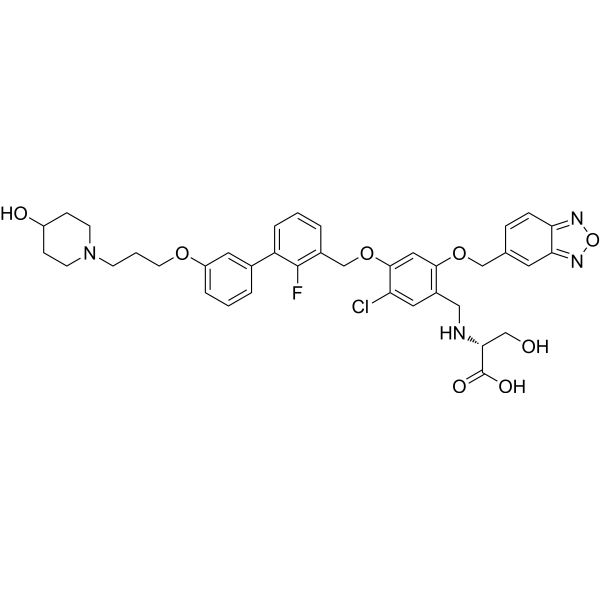
- HY-P99941
-
|
|
PD-1/PD-L1
|
Cancer
|
|
Retifanlimab is an anti-programmed cell death protein 1 (anti-PD-1) monoclonal antibody (mAb). Retifanlimab can be used for the research of gastroesophageal adenocarcinoma (GEA) [1].
|
-

- HY-P990077
-
|
CT-011; MDV9300
|
PD-1/PD-L1
|
Cancer
|
|
Pidilizumab (CT-011) is a humanized IgG1k anti-PD-1 monoclonal antibody. Pidilizumab acts as a DLL1 antagonist. Pidilizumab has the potential for hematologic malignancies research [1].
|
-

- HY-149830
-
|
|
PD-1/PD-L1
|
Cancer
|
|
PD-L1-IN-2 is a potential tumor immunological agent by inhibiting PD-L1. PD-L1-IN-2 is a Naamidine J derivative and exerts antitumor effects in vivo by reducing PD-L1 expression and enhancing tumor-infiltrating T-cell immunity. PD-L1-IN-2 is used for colorectal cancer research [1].
|
-
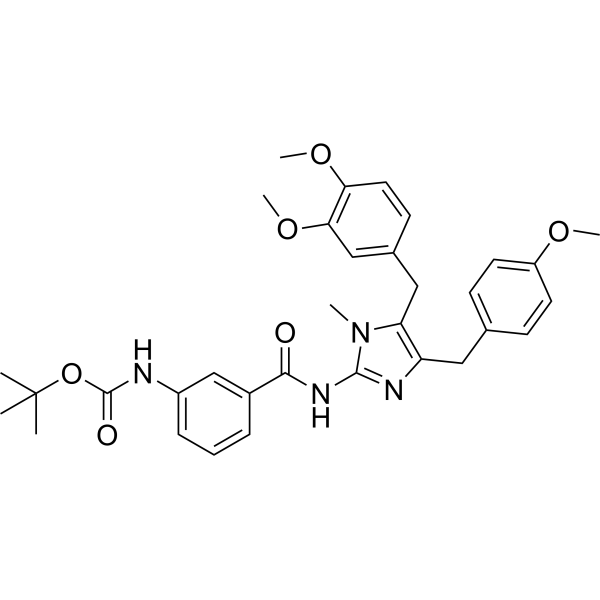
- HY-P99938
-
|
HX008
|
PD-1/PD-L1
|
Cancer
|
|
Pucotenlimab (HX008) is a humanized immunoglobulin G4 (IgG4) anti programmed cell death protein 1 (anti-PD-1) monoclonal antibody. Pucotenlimab can be used for the research of tumor [1].
|
-

- HY-P3139
-
|
|
PD-1/PD-L1
|
Cancer
|
|
TPP-1 is a potent inhibitor of the PD-1/PD-L1 interaction. TPP-1 binds specifically to PD-L1 with a high affinity (KD=95 nM). TPP-1 inhibits human tumor growth in vivo via reactivating T-cell function [1].
|
-
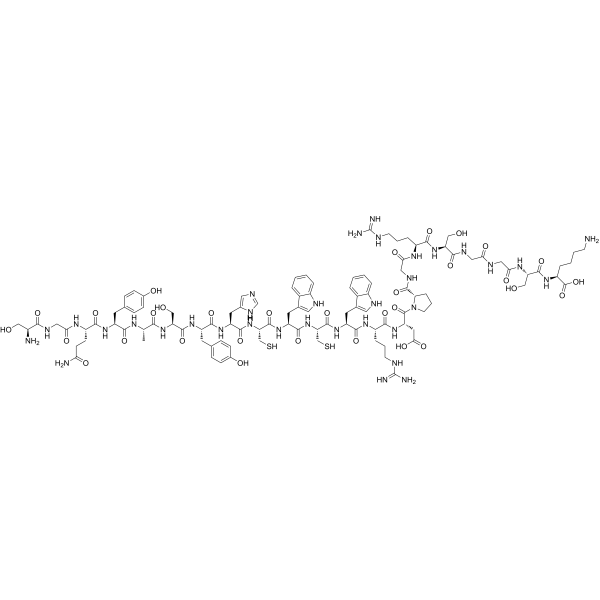
- HY-P3139A
-
|
|
PD-1/PD-L1
|
Cancer
|
|
TPP-1 TFA is a potent inhibitor of the PD-1/PD-L1 interaction. TPP-1 TFA binds specifically to PD-L1 with a high affinity (KD=95 nM). TPP-1 TFA inhibits human tumor growth in vivo via reactivating T-cell function [1].
|
-
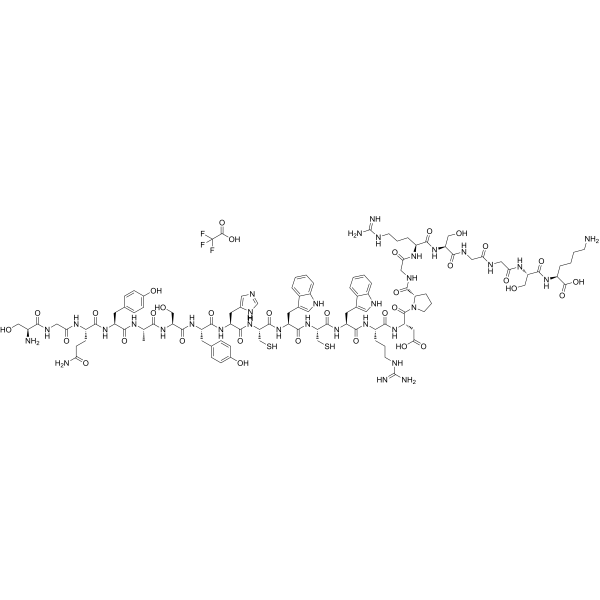
- HY-N12687
-
|
|
PD-1/PD-L1
Apoptosis
|
Cancer
|
|
Benzosceptrin C is an inhibitor for PD-L1, which promotes programmed cell death ligand (PD-L1) degradation in a lysosomal pathway, enhances the cytotoxicity of T-cells and exhibits antitumor activity [1].
|
-
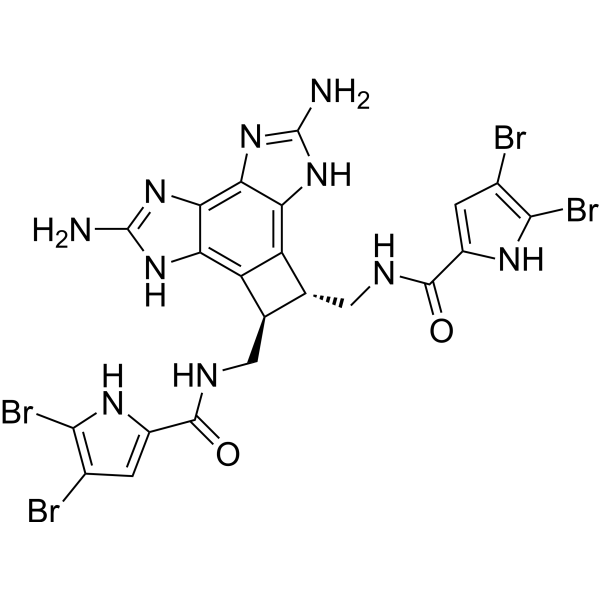
| Cat. No. |
Product Name |
Target |
Research Area |
-
- HY-103048A
-
|
|
PD-1/PD-L1
|
Cancer
|
|
PD-1/PD-L1-IN 3 TFA, a macrocyclic peptide, is a potent and selective inhibitor of the PD-1/PD-L1 and CD80/PD-L1 interactions extracted from patent WO2014151634A1, compound No.1. PD-1/PD-L1-IN 3 TFA interferes with PD-L1 binding to PD-1 and CD80 by binding to PD-L1, with IC50s of 5.60 nM and 7.04 nM, respectively. PD-1/PD-L1-IN 3 TFA can be used for the research of various diseases, including cancer and infectious diseases [1].
|
-
- HY-P2478
-
|
|
PD-1/PD-L1
|
Inflammation/Immunology
|
|
Human PD-L1 inhibitor V, a human PD-1 protein binding peptide with a Kd value of 3.32 μM. Human PD-L1 inhibitor V inhibit the interaction of hPD-1/hPD-L1 [1].
|
-
- HY-P1812
-
|
NP-12
|
PD-1/PD-L1
|
Cancer
|
|
AUNP-12 (NP-12) is a peptide antagonist of the PD-1 signaling pathway, displays equipotent antagonism toward PD-L1 and PD-L2 in rescue of lymphocyte proliferation and effector functions. AUNP-12 exhibits immune activation, excellent antitumor activity, and potential for better management of immune-related adverse events (irAEs) [1].
|
-
- HY-P10217
-
|
|
PD-1/PD-L1
|
Cancer
|
|
PD-1/PD-L1-IN-42 (Compound B8.4) is an inhibitor of the interaction between PD-1 and PD-L1, with an EC50 of 0.1 μM. PD-1/PD-L1-IN-42 can be used for the research of cancer immunotherapy [1].
|
-
- HY-P2478A
-
|
|
PD-1/PD-L1
|
Inflammation/Immunology
|
|
Human PD-L1 inhibitor V TFA, a human PD-1 protein binding peptide with a Kd value of 3.32 μM. Human PD-L1 inhibitor V TFA inhibit the interaction of hPD-1/hPD-L1 [1].
|
-
- HY-P1812A
-
|
NP-12 TFA
|
PD-1/PD-L1
|
Cancer
|
|
AUNP-12 TFA (NP-12 TFA) is a peptide antagonist of the PD-1 signaling pathway, displays equipotent antagonism toward PD-L1 and PD-L2 in rescue of lymphocyte proliferation and effector functions. AUNP-12 TFA exhibits immune activation, excellent antitumor activity, and potential for better management of immune-related adverse events (irAEs) [1].
|
-
- HY-P4072
-
|
|
PD-1/PD-L1
|
Cancer
|
|
(D)-PPA 1 is a hydrolysisresistant d-peptide antagonist. (D)-PPA 1 serves as a potent PD-1/PD-L1 inhibitor. (D)-PPA 1 binds to PD-1 with the affinity 0f 0.51 μM with in vitro and in vivo efficacy [1].
|
-
- HY-P4072A
-
|
|
PD-1/PD-L1
|
Cancer
|
|
(D)-PPA 1 TFA is a hydrolysisresistant d-peptide antagonist. (D)-PPA 1 TFA serves as a potent PD-1/PD-L1 inhibitor. (D)-PPA 1 TFA binds to PD-1 with the affinity 0f 0.51 μM with in vitro and in vivo efficacy [1].
|
-
- HY-P2477
-
|
|
PD-1/PD-L1
|
Inflammation/Immunology
|
|
Human PD-L1 inhibitor IV, a polypeptide, is a competitive human PD-1 protein inhibitor with a Kd value of 1.38 μM. Human PD-L1 inhibitor IV inhibits the interaction of hPD-1/hPD-L1 [1].
|
-
- HY-P10091
-
|
|
PD-1/PD-L1
|
Cancer
|
|
CD24/Siglec-10 blocking peptide, CSBP can not only block the interaction of CD24/Siglec-10 but also PD-1/PD-L1. CD24/Siglec-10 blocking peptide, CSBP can induce the phagocytosis of tumor cell [1].
|
-
- HY-P3143A
-
|
|
PD-1/PD-L1
|
Cancer
|
|
BMSpep-57 hydrochloride is a potent and competitive macrocyclic peptide inhibitor of PD-1/PD-L1 interaction with an IC50 of 7.68 nM. BMSpep-57 hydrochloride binds to PD-L1 with Kds of 19 nM and 19.88 nM in MST and SPR assays, respectively. BMSpep-57 hydrochloride facilitates T cell function by in creasing IL-2 production in PBMCs [1].
|
-
- HY-P3143
-
|
|
PD-1/PD-L1
|
Cancer
|
|
BMSpep-57 is a potent and competitive macrocyclic peptide inhibitor of PD-1/PD-L1 interaction with an IC50 of 7.68 nM. BMSpep-57 binds to PD-L1 with Kds of 19 nM and 19.88 nM in MST and SPR assays, respectively. BMSpep-57 facilitates T cell function by in creasing IL-2 production in PBMCs [1].
|
-
- HY-P3139
-
|
|
PD-1/PD-L1
|
Cancer
|
|
TPP-1 is a potent inhibitor of the PD-1/PD-L1 interaction. TPP-1 binds specifically to PD-L1 with a high affinity (KD=95 nM). TPP-1 inhibits human tumor growth in vivo via reactivating T-cell function [1].
|
-
- HY-P3139A
-
|
|
PD-1/PD-L1
|
Cancer
|
|
TPP-1 TFA is a potent inhibitor of the PD-1/PD-L1 interaction. TPP-1 TFA binds specifically to PD-L1 with a high affinity (KD=95 nM). TPP-1 TFA inhibits human tumor growth in vivo via reactivating T-cell function [1].
|
| Cat. No. |
Product Name |
Target |
Research Area |
-
- HY-P99144
-
-
- HY-P9902A
-
|
|
PD-1/PD-L1
|
Cancer
|
|
Pembrolizumab (anti-PD-1) is a humanized IgG4 antibody and PD-1 inhibitor. Pembrolizumab produces PD-1 blockade, preventing PD-L1 and PD-L2 from connecting to PD-1. This avoids the uncontrolled regulation of T cells on cells that normally express PD-1 [1] .
|
-
- HY-P9903A
-
|
|
PD-1/PD-L1
|
Cancer
|
|
Nivolumab (anti-PD-1) is a programmed death receptor-1 (PD-1) blocking human IgG4 antibody to treat advanced (metastatic) non-small cell lung cancer [1].
|
-
- HY-P99895
-
|
|
PD-1/PD-L1
|
Inflammation/Immunology
Cancer
|
|
Rulonilimab is a human IgG1 monoclonal antibody against PD-1 that targets, binds and inhibits PD-1 and its downstream signalling pathways with potential immune checkpoint inhibition and anti-tumour activity [1].
|
-
- HY-145771
-
|
|
PD-1/PD-L1
|
Cancer
|
|
PD-1/PD-L1-IN-20 (Example 21) is a small-molecule inhibitor of the PD-1/PD-L1 protein-protein interaction. PD-1/PD-L1-IN-20 blocks PD-1/PD-L1 with the IC50 of 5.29 nM. PD-1/PD-L1-IN-20 can be used for the research of cancers, infectious diseases and autoimmune diseases [1].
|
-
- HY-P99884
-
|
PF-06801591
|
PD-1/PD-L1
|
Others
|
|
Sasanlimab (PF-06801591) is a humanized IgG4-κ antibody targeting PD-1. Mainly expressed by CHO (Chinese Hamster Ovary) cells [1].
|
-
- HY-P99457
-
-
- HY-P99106
-
|
|
PD-1/PD-L1
|
Cancer
|
|
Acrixolimab a humanized IgG4-κ antibody, targeting to PD-1 [1] .
|
-
- HY-P99887
-
|
JTX-4014
|
PD-1/PD-L1
|
Cancer
|
|
Pimivalimab (JTX-4014) is a PD-1 inhibitor. Pimivalimab can be used for the research of solid tumor [1].
|
-
- HY-P99618
-
|
IBI-315; BH2950
|
EGFR
PD-1/PD-L1
|
Inflammation/Immunology
Cancer
|
Fidasimtamab (IBI-315; BH2950) is a recombinant human IgG1 bispecific antibody that targets, binds and inhibits both HER2 and PD-1 and their downstream signalling pathways, and links PD-1 expressing T cells to HER2 expressing tumour cells. Fidasimtamab has potential immunosuppressive and antitumor activity [1].
|
-
- HY-P9902
-
|
MK-3475; Lambrolizumab
|
PD-1/PD-L1
|
Cancer
|
|
Pembrolizumab (MK-3475) is a humanized IgG4 antibody inhibiting the programmed cell death 1 (PD-1) receptor, used in cancer immunotherapy.
|
-
- HY-P99619
-
|
SCT-I10A
|
PD-1/PD-L1
|
Cancer
|
|
Finotonlimab (SCT-I10A) is a recombinant humanised IgG PD-1 antibody. Finotonlimab has the potential for solid tumors or lymphomas research [1].
|
-
- HY-P99203
-
|
|
PD-1/PD-L1
|
Cancer
|
|
Cemiplimab (Anti-Human PD-1) is a high-affinity programmed death receptor-1 (PD-1) monoclonal IgG4 antibody that blocks PD-1/PD-L1-mediated T-cell suppression. Cemiplimab is commonly used in squamous cell skin cancer research [1] .
|
-
- HY-P9978
-
|
|
PD-1/PD-L1
|
Cancer
|
|
Toripalimab is the first domestic anti-tumor PD-1 antibody in China. Toripalimab is a selective, recombinant, humanized monoclonal antibody against PD-1. Toripalimab is able to bind to PD-1 and block the interaction with its ligands. Toripalimab has exhibited primary anti-tumor effects in tumors such as melanoma, lung cancer, digestive tract tumors, hepatobiliary and pancreatic tumors, neuroendocrine neoplasms, nasopharyngeal carcinoma and urothelial carcinoma [1].
|
-
- HY-P99544
-
|
HBM-9167; KL-A167
|
PD-1/PD-L1
|
Cancer
|
|
Tagitanlimab (HBM-9167) is a humanized anti-PD-L1 antibody (IgG1κ type). Tagitanlimab selectively blocks the interaction of PD-L1 and PD-1. Tagitanlimab has the potential to be studied in recurrent or metastatic nasopharyngeal carcinoma (NPC) [1] .
|
-
- HY-P99048
-
|
IBI308
|
PD-1/PD-L1
|
Inflammation/Immunology
Cancer
|
|
Sintilimab (IBI308) is a fully human IgG4 monoclonal antibody that binds to PD-1, thereby blocking the interaction of PD-1 with its ligands (PD-L1 and PL-L2) and consequently helping to restore the endogenous antitumour T-cell response. Sintilimab can be used for the research of classical Hodgkin's lymphoma, non-small cell lung cancer and oesophageal cancer [1].
|
-
- HY-P99714
-
|
MGD019
|
PD-1/PD-L1
CTLA-4
|
Cancer
|
|
Lorigerlimab (MGD019) is a bispecific IgG4 dual-affinity re-targeting antibody (DART). Lorigerlimab can block PD-1 and CTLA-4, and improves T-cell responses. Lorigerlimab can be used for research of metastatic castration-resistant prostate cancer (mCRPC) [1] .
|
-
- HY-P9972
-
|
pdR001
|
PD-1/PD-L1
|
Cancer
|
|
Spartalizumab (PDR001) is a humanized immunoglobulin 4 monoclonal antibody that binds PD-1 with subnanomolar activity and blocks interaction with PD-L1 and PD-L2. Spartalizumab can be used for the research of anaplastic thyroid carcinoma (ATC) [1].
|
-
- HY-P99833
-
|
CK-301; TG-1501
|
PD-1/PD-L1
|
Cancer
|
|
Cosibelimab (CK-301; TG-1501) is a high-affinity, fully human PD-L1-blocking monoclonal antibody that binds PD-L1 and blocks its interaction with PD-1. Cosibelimab has a functional Fc domain and is capable of inducing ADCC and complement-dependent cytotoxicity (CDC)-mediated killing of PD-L1 + cell lines, including lymphoma cells [1].
|
-
- HY-P99687
-
|
AMG 256
|
PD-1/PD-L1
|
Cancer
|
|
Latikafusp (AMG 256) is a bifunctional fusion protein comprising a PD-1-targeting antibody and IL-21 mutein designed to deliver IL-21 pathway stimulation to PD-1+ cells. Latikafusp is designed to prime and extend the activity of cytotoxic and memory T cells and induce anti-tumor immunity. Latikafusp has the potential for solid tumors research [1] .Latikafusp may lead to the development of immunogenicity-mediated responses .
|
-
- HY-P99052
-
|
|
PD-1/PD-L1
|
Inflammation/Immunology
Cancer
|
|
Tislelizumab, a monoclonal antibody with high binding affinity to the PD-1 receptor, minimizes Fcγ receptor binding on macrophages, thereby abrogating antibody-dependent phagocytosis, a mechanism of T cell clearance and potential resistance to anti-PD-1 research. Tislelizumab can be used for the research of advanced squamous non-small-cell lung cancer [1].
|
-
- HY-P99166
-
|
|
PD-1/PD-L1
CTLA-4
|
Inflammation/Immunology
|
|
Vudalimab is a potent dual PD-1 and CTLA-4 inhibitor as a fully humanized bispecific monoclonal antibody. Vudalimab targets immune checkpoint receptors PD-1 and CTLA-4 and promotes tumor-selective T-cell activation [1].
|
-
- HY-P990072
-
|
|
PD-1/PD-L1
|
Cancer
|
|
Lipustobart is an IgG4-kappa, anti-PDCD1 (programmed cell death 1, PD1, PD-1, CD279) humanized monoclonal antibody. Lipustobart shows immunostimulant and antineoplastic activity [1].
|
-
- HY-P9971
-
|
SHR-1210
|
PD-1/PD-L1
|
Cancer
|
|
Camrelizumab (SHR-1210) is a potent humanied high-affinity IgG4-κ monoclonal antibody (mAb) to PD-1. Camrelizumab binds PD-1 at a high affinity of 3 nM and inhibits the binding interaction of PD-1 and PD-L1 with an IC50 of 0.70 nM. Camrelizumab acts as anti-PD-1/PD-L1 agent and can be used for cancer research, including NSCLC, ESCC, Hodgkin lymphoma, and advanced HCC et,al [1] .
|
-
- HY-P99639
-
|
APL-501; CBT-501; GB-226
|
PD-1/PD-L1
|
Cancer
|
|
Geptanolimab (CBT-501) is a humanized IgG4k monoclonal antibody against programmed death-1 (PD-1). Siplizumab inhibits the binding of PD-L1/L2 to PD-1 through a competitive action. Siplizumab can be used in research of cancer [1].
|
-
- HY-P99499
-
|
JNJ 63723283; JNJ 3283
|
PD-1/PD-L1
Interleukin Related
TNF Receptor
|
Cancer
|
|
Cetrelimab (JNJ 63723283; JNJ 3283) is a human IgG4κ mAb targeting PD-1. Cetrelimab binds PD-1 (Kd=1.72 nM, HEK293) to block the interaction of PD-1 with PD-L1 and PD-L2 (IC50s=111.7 ng/mL and 138.6 ng/mL, respectively). Cetrelimab stimulates peripheral T cells, increases IFN-γ, IL-2, TNF-α level and inhibits tumor growth in vivo [1].
|
-
- HY-P9997
-
|
ANB030
|
PD-1/PD-L1
|
Cancer
|
|
Rosnilimab is a humanized IgG1-κ antibody targeting to PD-1 [1] .
|
-
- HY-P99957
-
|
AMG-404
|
PD-1/PD-L1
|
Cancer
|
|
Zeluvalimab (AMG-404) is a monoclonal antibody targeting the PD-1 receptor that can be used for the research of cancer [1].
|
-
- HY-P99679
-
-
- HY-P990029
-
|
|
PD-1/PD-L1
|
Infection
Cancer
|
|
Eciskafusp alfa is a programmed cell death 1 (PDCD1, best known as PD-1) cis-targeted IL2v immunocytokine. Eciskafusp alfa preferentially targets antigen-specific stem-like PD-1+ TCF-1+ CD8+ T cells and differentiates them towards a novel population of better effectors. Eciskafusp alfa can be used for the research of cancer and chronic infections [1].
|
-
- HY-P99641
-
|
|
PD-1/PD-L1
|
Cancer
|
|
Gilvetmab is a potent caninized antiPD-1 monoclonal antibody. gilvetmab blocks the interaction between PD-1 and its ligand PDL-1 [1].
|
-
- HY-P9903
-
Nivolumab
Maximum Cited Publications
16 Publications Verification
BMS-936558; ONO-4538; MDX-1106
|
PD-1/PD-L1
|
Cancer
|
|
Nivolumab is a programmed death receptor-1 (PD-1) blocking human IgG4 antibody to treat advanced (metastatic) non-small cell lung cancer.
|
-
- HY-P99109
-
|
GLS-010; AB-122; WBP-3055
|
PD-1/PD-L1
|
Cancer
|
|
Zimberelimab (GLS-010) is a fully human IgG4 anti-PD-1 monoclonal antibody with an EC50 of 210 pM for human PD-1. Zimberelimab effectively blocks the binding of PD-L1 and PD-L2 to cell-surface PD-1 in CHO-S cells, with IC50 values of 580 pM and 670 pM, respectively. Zimberelimab shows antitumor activities, and can be used for various cancers research, including cervical cancer, non-small cell lung cancer and classical Hodgkin’s lymphoma [1] .
|
-
- HY-P9993
-
|
LY-3462817
|
PD-1/PD-L1
|
Cancer
|
|
Peresolimab is a humanized IgG1-κ antibody targeting to PD-1. Peresolimab potentially stimulates physiological immune inhibitory pathways to restore immune homeostasis [1] .
|
-
- HY-P99117
-
|
AK104
|
PD-1/PD-L1
|
Cancer
|
|
Cadonilimab (AK104) is a targeting PD1/CTLA4 IgG1 scaffold Fc-engineered humanized antibody. Cadonilimab can be used for researching metastatic cervical cancer [1] .
|
-
- HY-P99489
-
|
ABBV 181; PR 1648817
|
PD-1/PD-L1
|
Cancer
|
|
Budigalimab (ABBV 181; PR 1648817) is a humanized IgG1 monoclonal antibody targeting programmed cell death 1 (PD-1) receptor. Budigalimab is Fc mutated thus to reduce Fc receptor interactions and limit effector function [1].
|
-
- HY-P99610
-
|
BI-754091
|
PD-1/PD-L1
|
Cancer
|
|
Ezabenlimab (BI-754091) is an anti-PD-1 mAb with binding constant Kd value of 6 nM (CHO cells). Ezabenlimab blocks the interaction of PD-1 with PD-L1 and PD-L2. Ezabenlimab increases interferon-γ secretion in T cells, and inhibits tumor growth in vivo [1].
|
-
- HY-P99345
-
|
TSR-042
|
PD-1/PD-L1
|
Cancer
|
|
Dostarlimab (TSR-042) is a humanized anti-PD-1 monoclonal antibody. Dostarlimab binds with high affinity to human PD-1 and competitively inhibits its interaction with its ligands, PD-L1 and PD-L2, with IC50s of 1.8 and 1.5 nM, respectively [1].
|
-
- HY-P99633
-
|
BGB-A333
|
PD-1/PD-L1
Apoptosis
|
Cancer
|
|
Garivulimab (BGB-A333) is a humanized IgG1-variant monoclonal antibody that specifically targets and binds to PD-L1. Garivulimab selectively blocks the interaction of PD-L1 and PD-1. Garivulimab has antitumor activity [1].
|
-
- HY-P9919
-
|
MEDI 4736
|
PD-1/PD-L1
|
Cancer
|
|
Durvalumab (MEDI 4736) is an human anti-PD-L1 monoclonal antibody [1]. Durvalumab (MEDI4736) completely blocks the binding of PD-L1 to both PD-1 and CD80, with IC50s of 0.1 and 0.04 nM, respectively .
|
-
- HY-P99115
-
|
ASC 22; KN 035
|
PD-1/PD-L1
|
Cancer
|
|
Envafolimab (ASC 22; KN 035) is a recombinant protein of a humanized single-domain anti- PD-L1 antibody. Envafolimab is created by a fusion of the of anti-PD-L1 domain with Fc fragment of human IgG1 antibody. Envafolimab blocks interaction between PD-L1 and PD-1 with an IC50 value of 5.25 nM. Envafolimab has the potential for the research of solid tumors [1] .
|
-
- HY-P99807
-
|
BCD-100
|
PD-1/PD-L1
|
Cancer
|
|
Prolgolimab (BCD-100) is a human IgG1 anti-PD-1 monoclonal antibody containing the Fc-silencing 'LALA' mutation. Prolgolimab can be used for the research of advanced melanoma [1].
|
-
- HY-P99540
-
|
PSB-205; QL1706 (iparomlimab/tuvonralimab); PBS105
|
PD-1/PD-L1
CTLA-4
|
Cancer
|
|
Tuvonralimab (PSB-205; QL1706) is a dual immune checkpoint blockade containing a mixture of anti-PD-1 IgG4 and anti-CTLA-4 IgG1 antibodies, Iparomlimab and Tuvonralimab [1].
|
-
- HY-P99675
-
|
AK112
|
PD-1/PD-L1
VEGFR
|
Cancer
|
|
Ivonescimab (AK112) is a PD-1/VEGF Bispecific Antibody. Ivonescimab can be used for cancer research [1] .
|
-
- HY-P9996
-
|
LY3434172
|
PD-1/PD-L1
|
Cancer
|
|
Reozalimab is a bispecific antibody targeting to PD-1/PD-L1. Reozalimab mediates antibody-dependent cell cytotoxicity in cancer research [1] .
|
-
- HY-P99100
-
|
CTL-002
|
PD-1/PD-L1
|
Cancer
|
|
Visugromab is aGDF-15 neutralizing IgG4 mAb. Visugromab exhibits potent effecicacy in PD-1/PD-L1 relapsed/refractory metastatic solid tumors [1].
|
-
- HY-P99709
-
|
LY3300054
|
PD-1/PD-L1
|
Cancer
|
|
Lodapolimab (LY3300054) is an IgGλ anti-PD-1 monoclonal antibody [1].
|
-
- HY-P99422
-
|
SHR-1316
|
PD-1/PD-L1
Apoptosis
|
Cancer
|
|
Adebrelimab (SHR-1316) is a humanized IgG4 monoclonal PD-L1 (PD-1/PD-L1) antibody. Adebrelimab has promising antitumor activity in solid tumors including extensive-stage small-cell lung cancer (SCLC) [1] .
|
-
- HY-P99108
-
-
- HY-P99419
-
|
GEN1046
|
PD-1/PD-L1
|
Cancer
|
|
Acasunlimab (GEN1046) is a bispecific antibody (bsAb) targeting PD-L1 and 4-1BB. Acasunlimab enhances T-cell and NK-cell function through conditional 4-1BB stimulation while constitutively blocking the PD-1/PD-L1 inhibitory axis. Acasunlimab can be used in research of cancer [1] .
|
- HY-P99668
-
|
|
PD-1/PD-L1
|
Cancer
|
|
Iparomlimab is an anti-human PD-1/CD279/PDCD1 IgG4κ antibody. Iparomlimab also targets to human monoclonal PSB103 γ4-chain, disulfided with human monoclonal PSB103 κ-chain to form a dimer. Iparomlimab can be used for Oncology research [1].
|
- HY-P99118
-
|
HLX 10
|
PD-1/PD-L1
|
Cancer
|
|
Serplulimab (HLX 10) is humanized monoclonal anti-PD-1 antibody. Serplulimab can be used in research of small cell lung cancer [1].
|
- HY-P99963
-
|
HS636
|
PD-1/PD-L1
|
Cancer
|
|
Sudubrilimab (HS636) is an Ig G1-kappa monoclonal antibody against PDL1. Sudubrilimab is fused at the C terminus of the heavy chain to a TGF-β1 receptor Ⅱ ectodomain (TGFBR2-ECD), and which can sequester the PD-1/PD-L1 pathway and TGF-β bioactivity in the immunosuppressive tumor microenvironment [1].
|
- HY-P99758
-
|
CS1003
|
PD-1/PD-L1
|
Cancer
|
|
Nofazinlimab (CS1003) is a humanised IgG4 anti-PD-1 monoclonal antibody. Nofazinlimab can be used for unresectable hepatocellular carcinoma (uHCC) research [1].
|
- HY-P99941
-
|
|
PD-1/PD-L1
|
Cancer
|
|
Retifanlimab is an anti-programmed cell death protein 1 (anti-PD-1) monoclonal antibody (mAb). Retifanlimab can be used for the research of gastroesophageal adenocarcinoma (GEA) [1].
|
- HY-P990077
-
|
CT-011; MDV9300
|
PD-1/PD-L1
|
Cancer
|
|
Pidilizumab (CT-011) is a humanized IgG1k anti-PD-1 monoclonal antibody. Pidilizumab acts as a DLL1 antagonist. Pidilizumab has the potential for hematologic malignancies research [1].
|
- HY-P99938
-
|
HX008
|
PD-1/PD-L1
|
Cancer
|
|
Pucotenlimab (HX008) is a humanized immunoglobulin G4 (IgG4) anti programmed cell death protein 1 (anti-PD-1) monoclonal antibody. Pucotenlimab can be used for the research of tumor [1].
|
| Cat. No. |
Product Name |
Category |
Target |
Chemical Structure |
| Cat. No. |
Product Name |
|
Classification |
-
- HY-162356
-
|
|
|
Azide
|
|
PD-L1-IN-4 (Compound X18) is an orally active PD-L1 inhibitor that exhibits remarkable inhibitory activity against the PD-1/PD-L1 interaction (IC50 = 1.3 nM) and enhances PD-L1 inhibitory effect on T cells (EC50 = 152.8 nM). PD-L1-IN-4 can be used for the research of cancer [1].
|
Your information is safe with us. * Required Fields.
Inquiry Information
- Product Name:
- Cat. No.:
- Quantity:
- MCE Japan Authorized Agent:




















































































































































